#film noir is the superior genre
Text
Thinkin abt The Long Halloween film, (& spoilers for it), and remembered someone once complaining they made Gilda’s character bad in the film adaptation of The Long Halloween and a whole ‘she’s just evil because she can’t have kids anymore’ trope and like??? I have to kick in a door and say HUH??? What movie did you see?? Like the character is hella different from the comic yes, but 1, not necessarily in a bad way, a 2, that’s not her motive??? At all?? Like she’s not happy about that, but she’s not ever a ‘im inhuman now I can’t bear kids…’ The woman wants revenge because she experienced an insane trauma, and a betrayal, and the justice system is so broken that even as a lawyer herself, doing everything right, it left her empty and broken and abandoned too.
If anything, she’s just a strong foil for Harvey. She is never like ‘I can’t bear kids so now I must kill’— she’s like ‘I was in love and engaged to the man of my dreams and pregnant with our child, starting my career and family and unbelievably happy, and then his mafia father said ‘no’ to the union and child, and he just…abandoned me. For the family. I fought it, and he didn’t. He didn’t stay, he didn’t protect me, he didn’t love me. He didn’t even try. He let them cut my child out and kill it in front of me while I went kicking and screaming and fighting under the blade 8 months pregnant in a gang nonconsensual abortion, and left me literally hollowed out and alone to ‘recover’ from that, and nothing changed for anyone but me. I died that day, and no one faced ANY consequence. Not even guilt. I lost my ability to do my job, I lost my future, my hope, my ambition, my kid, my plans, my personality, my desire, my emotions, my being. I walked around as a shell. And when the justice system failed me, I found a lawyer who cared and was gunning for that mafia family, and married him, gave him more reason, but even he and Batman and the whole police force weren’t enough to stop them, so I decided to do it myself. I killed them, one holiday at a time, until everyone I wanted dead was fucking dead, and I got my justice.”
That’s an incredibly understandable, well done motive. What she did to Harvey specifically is fucked as hell, but she’s not a badly written lady. I love her comment about Harvey at the end that “We were so similar. Just. What was inside him hadn’t been ripped out yet.” Because she knows (and literally says) how broken and hollow what happened to her made her, and she can tell that what’s happened to him by the end of the story has done the same thing. She’s an incredibly cold and brutal character, but the bitch is well written.
Like, she’s an excellent tragic film noir parallel for Harvey in the film. They go through almost the same trajectory. She is a hopeful young lawyer who believes in Justice who is betrayed and broken by the Roman’s people, and turns to extreme violence outside the system to get her justice when the ‘right way’ fails her. Harvey is literally the exact same thing, and scarred the exact same way, and changes to violence because of it. They both even say the very iconic ‘It had to be done’ close to the end of the film, in their last major scenes. Not echoing each other—neither hears the other. They just felt the same. The deep tragedy of the narrative is that in her search for justice, Gilda did to Harvey what was done to her—an utter betrayal and abandonment by beloved spouse. And he does not do to her what Alberto did. He takes the fall for her, even after the things she’s done, to him, because he loves her. The narrative repeats, the cycle of pain repeats, with the Roman at the heart of it, but with slight aberration because of the people involved this time. And if that ain’t film noir.
#it’s never about the childbearing. she says that herself her literal words are ‘What they did to me? The /way/ it was done? Left me broken.’#Gilda Dent#The Long Halloween#the long halloween spoilers#Batman#the long halloween film#film noir is the superior genre#the tragedy??? of the fact Gilda is /so/ broken by her experiences she trusts no one. even Harvey. she asks Batman — even /knowing/ he went#to jail and confessed to her crimes — if Harvey is the one who told him what she did/turned her in. she still cannot believe someone would#not betray her—would love her enough not to. and one of Two-Face’s last lines — when told he’s betrayed everything he stood for — is ‘not.#everything.’ right after which he takes the fall for his wife and goes to jail as a serial killer he isn’t to protect her. his last line in#the film is ‘Gilda.’ he loved her. but she was broken too badly to believe that was soemthing she could believe anymore by the time she got#him. the film is a tragedy. Gilda Dent fucked over her husband so bad and I’m big mad but she’s hella well written#her absolute panic after the first murder? when he comes home and she’s alone on the swing & you worry she’s dead for a second#and she asks him to not leave her and gets really distressed??? that scene makes no sense the first time but when you get it??? when you get#the whole story?? Jesus Christ Gilda. like she is dead on the inside almost nothing left & that pilot light. …
19 notes
·
View notes
Text
Gathering of the Greatest Gumshoes - Number 28
Welcome to A Gathering of the Greatest Gumshoes! During this month-long event, I’ll be counting my Top 31 Favorite Fictional Detectives, from movies, television, literature, video games, and more!
SLEUTH-OF-THE-DAY’S QUOTE: “Change never comes without pain.”
Number 28 is…Adam Jensen, from Deus Ex.
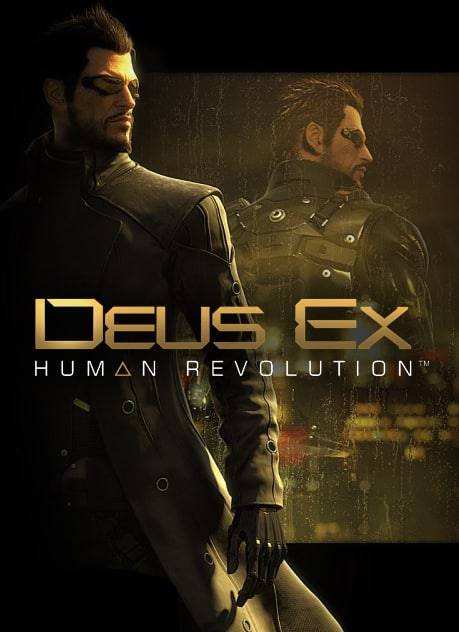
A specific friend of mine introduced me to the Deus Ex games, via their two most recent releases: “Human Revolution” and “Mankind Divided,” both of which apparently act as prequels to the rest of the series. I know absolutely nothing about all the other games in the franchise, but as far as these two games go…I think they’re pretty interesting! The games are a sort of combo of sci-fi and film noir, taking place in a futuristic world where many human beings have “augmented” themselves with bionic materials, for various reasons. In each game, your main character is this guy: Adam Jensen, a frankly much better cyborganic sleuth than Inspector Gadget.
Then again, I think a pencil would make a better cyborganic sleuth than Inspector Gadget, and it’s neither a cyborg NOR a sleuth, so…take that as you will.
Anyway: voiced by Elias Toufexis (who apparently is a big fan of noir and pulp style fiction, such as The Shadow), Jensen starts off in “Human Revolution” as a security investigator for a tech company called Sarif Industries. After being horribly wounded in an attack on the company, Jensen is augmented without his consent, and his girlfriend – Megan – is apparently killed. Despite his MANY reservations, Jensen goes out to try and discover exactly what happened, using his newfound augmentations to help him along the way. His investigations lead to him uncovering a vast conspiracy, with ties to the Illuminati, of all things. In “Mankind Divided,” Jensen has left Sarif Industries in favor of working for Interpol, acting as an agent for an elite anti-terrorist squad. He once again runs afoul of the Illuminati in the process of investigating a railway bombing, and once more goes on the hunt to find the perpetrators, using his special tools and skills to track down the criminals. Along the way, in both titles, Jensen also comes across various other cases and side missions, each of which show the different dark corners of the world he lives in.
A big part of both games – and, from what I understand, the Deus Ex franchise as a whole – is the theme of what makes a person truly human. In a world where people are replacing their limbs and organs en-masse with “superior,” artificial contraptions, how much can you do to the human body before it stops BEING a human body? What makes an individual different from the crowd, and what separates people from the machines we build? How much choice and free will does one really have in the world? These are themes integral to both science fiction AND noir-style detective stories, and both titles meld the two genres exquisitely. Jensen, his allies, and the foes he faces present different viewpoints on a world like this, and offer different perspectives on this fundamental question.
Jensen is a classic detective character of this sort; he’s like a cross between the aforementioned Cole Phelps and a superhero of some sort. He’s not unwilling to use violence and direct force on his enemies, and he has plenty of firepower to go around, but much of each game is really about him tracking leads, picking out clues, and asking questions as he tries to get to the bottom of the truth of each matter. These are a couple of those lovely video games where the choices the player makes throughout the story – from simply deciding whether to use stealth or full-faced aggressive tactics, to deciding what messages to share with the people of the world – effect the plot and other characters’ perception of the main protagonist. But even with that said, Jensen has several things that remain consistent: his dry, sarcastic sense of humor, his stonefaced demeanor, and his somewhat cynical outlook on his own life.
Perhaps the most noteworthy element, however, is his sense of independence. It’s interesting and fitting that Adam’s journey effectively begins with him being forced into situations beyond his control, because from that point on, you could argue his entire mission in both stories is to find exactly that. Jensen prefers to work alone, as much as possible, and clearly resents being put in the position he is. How he comes to feel about his augmentations, and the concept of augmented people in general, can change depending on how the player handles things, but overall it’s fair to say that, for all the advantages they give him, he also knows they have clear disadvantages, too. As the story of each game grows more complex, so do the choices Jensen has to face. As a result, the player goes from having no choice in what happens to having incredible responsibility heaped onto their shoulders. It’s a unique progression for both the character and each game in general, and it’s part of what makes this sci-fi sleuth so memorable.
Tomorrow, the countdown continues with Number 27!
CLUE: “The world will look up and shout ‘Save us!’ And I’ll whisper, ‘No.’”
#list#countdown#best#favorites#top 31 fictional detectives#gathering of the greatest gumshoes#number 28#adam jensen#elias toufexis#deus ex#video games#human revolution#mankind divided#sci-fi#mystery#noir
3 notes
·
View notes
Photo
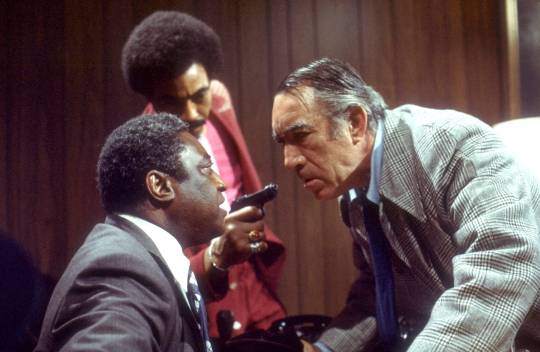
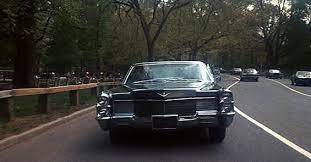

Across 110th Street (1972) 112 minutes, Rated R
I loved this film. It is the first movie featured in ‘TCM Underground’ and while the authors of that book encourage us to watch the movies out of order, that’s not how my brain works.
For certain, I didn’t expect to like the movie as much as I did. I am generally not an Anthony Quinn fan and expected to dislike this movie because he is the star. It’s so good to be wrong sometimes. I feel refreshed from having watched this gritty, new-to-me, neo-noir and have not stopped talking about since I watched it on Thursday.
I was excited to see Burt Young in the opening scene. Young is a classic Italian character actor who I instantly recognized but he was gunned down before he says a word. Two black ‘cops’ who we quickly find out are not cops - rob the mob for $300,000 - and kill two actual cops.
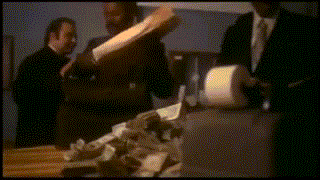
The whole movie takes place in Harlem - real Harlem with real people - real buildings - real sound - real desperation and poverty. Quinn is the seasoned detective and Yaphett Koto is the educated superior officer. The two clash over methods and neither is very successful at solving the case.
In one scene - the mob lets on to the new superior officer that they have been paying Quinn off for many years. The new guy doesn’t flinch but Quinn does - he worries for his pension and his future and what would happen to him if someone were to rat him out. He makes excuses - and tries to minimize what he’s done.
Oh my - and another favourite scene was when the mob boss’ son-in-law goes into Harlem to see the bad-guy-in-charge there about what happened to his father-in-law’s money. The bad-guy-in-charge, played by Richard Ward, is so good. His gravelly voice is menacing as he yells at the son-in-law and says, “you ain’t never gonna make it - what are you 40-45 - you were a punk errand boy when you married the boss’ daughter and you’re still a punk errand boy”. Freaking classic mental torture - I really loved it.
Across 110th Street is unexpected and refreshing. It makes me a little sad that this movie came out in the same year as The Godfather but 110th Street is never discussed as the same class of film. To me it is better than The Godfather because everything in the movie happens to real people. And the ending - the ENDING! An entire movie can be ruined by a stupid ending. Across 110th Street has a fantastic ending.
I read on IMDB that Quinn wanted the trifecta - Sammy Davis, Jr., Harry Belafonte, and Sidney Poitier in the lead roles. But Harlem said no - those are Hollywood names. I’m not saying it would have been bad - but it would have been a different movie - sort of white washed and sanitized rather than the dirty crime thriller this turned out to be.
Dirty 70′s crime drama is my 3rd favorite film genre.
I rented the DVD from the library - it was super easy to find. I only wish I had heard of it sooner. But now is also a good time to learn about it since it fit right in to this cult series.
#across 110th street#cult classics#cult films rule#tcm underground#richard ward#anthony quinn#yaphet kotto
2 notes
·
View notes
Text
Special Feature: The Hitch-hiker (1953)
Yep, this is not quite a horror film. But given the week’s subject, I thought discussing the first American noir film directed by a woman would be worthwhile. After all, suspense is an adjacent genre to horror as the ability to keep things tense can make or break a film there. So, what does the movie have to offer?
Directed by Ida Lupino, it’s based on a story by Daniel Mainwaring (who goes uncredited for being blacklisted at the time) which was then adapted by Robert L. Joseph.… all inspired by the real murder spree of Billy Cook, albeit with names and details changed of course. Roy Collins and Gilbert Bowen are going on a fishing trip to Mexicali, and they decide to give a hitchiker they come across a ride. This decision unfortunately proves to be the worst mistake of their lives as they’re taken hostage at gunpoint by someone who turns out to be the wanted criminal known Emmet Myers. And now, their captor is demanding them to drive into the desert as both the American and Mexican police are on their tail.
If there’s something Lupino absolutely NAILS to a T here, that’s got to the pacing. By minute 8 has the set up clear as day and the tension through the roof, so the rest of the movie can build upn the goose chase by the police and the battle of resolve between two decent men against someone who knows no remorse in his hardened psychopathy, openly reveling in humiliating others to assert his misplaced sense of superiority.
It really doesn't get more simple than two people being held at gunpoint by a third one, but it doesn't need to. There's no pointless subplots, fluff or cheap attempts to garner the audience's sympathy with melodrama. It just gets to the point with no fat and that's what makes it a classic.
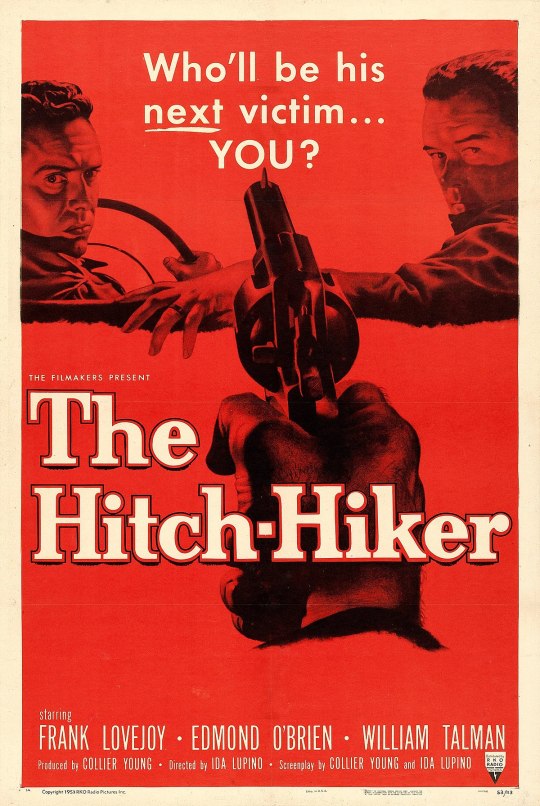
0 notes
Text
0 notes
Photo
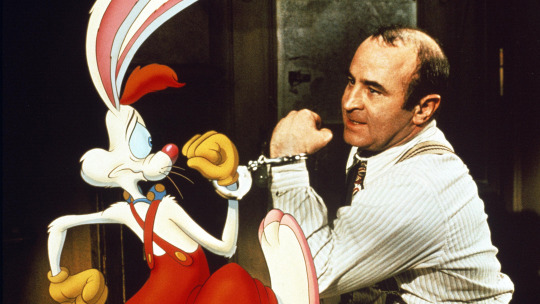
Blurring the Line.
As a new Space Jam film beams down to Earth, Kambole Campbell argues that a commitment to silliness and a sincere love for the medium is what it takes to make a great live-action/animation hybrid.
The live-action and animation hybrid movie is something of a dicey prospect. It’s tricky to create believable interaction between what’s real and what’s drawn, puppeteered or rendered—and blending the live and the animated has so far resulted in wild swings in quality. It is a highly specific and technically demanding niche, one with only a select few major hits, though plenty of cult oddities. So what makes a good live-action/animation hybrid?
To borrow words from Hayao Miyazaki, “live action is becoming part of that whole soup called animation”. Characters distinct from the humans they interact with, but rendered as though they were real creatures (or ghosts), are everywhere lately; in Paddington, in Scooby Doo, in David Lowery’s (wonderful) update of Pete’s Dragon.
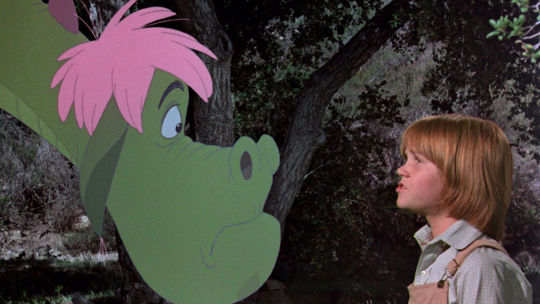
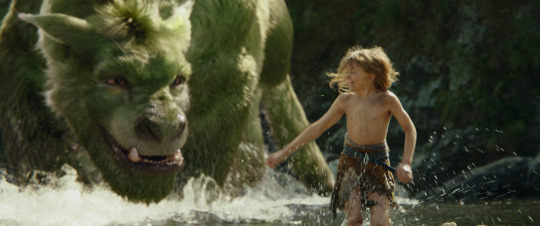
The original ‘Pete’s Dragon’ (1977) alongside the 2016 remake.
Lowery’s dragon is realized with highly realistic lighting and visual-effects work. By comparison, the cartoon-like characters in the 1977 Pete’s Dragon—along with other films listed in Louise’s handy compendium of Disney’s live-action animation—are far more exaggerated. That said, there’s still the occasional holdout for the classical version of these crossovers: this year’s Tom and Jerry replicating the look of 2D through 3D/CGI animation, specifically harkens back to the shorts of the 1940s and ’50s.
One type of live-action/animation hybrid focuses on seamless immersion, the other is interested in exploring the seams themselves. Elf (2003) uses the aberration of stop-motion animals to represent the eponymous character as a fish out of water. Ninjababy, a Letterboxd favorite from this year’s SXSW Festival, employs an animated doodle as a representation of the protagonist’s state of mind while she processes her unplanned pregnancy.
Meanwhile, every Muppets film ever literally tears at the seams until we’re in stitches, but, for the sake of simplicity, puppets are not invited to this particular party. What we are concerned with here is the overlap between hand-drawn animation and live-action scenes (with honorable mentions of equally valid stop-motion work), and the ways in which these hybrids have moved from whimsical confections to nod-and-wink blockbusters across a century of cinema.

Betty Boop and Koko the clown in a 1938 instalment of the Fleischer brothers’ ‘Out of the Inkwell’ series.
Early crossovers often involve animators playing with their characters, in scenarios such as the inventive Out of the Inkwell series of shorts from Rotoscope inventor Max Fleischer and his director brother Dave. Things get even more interactive mid-century, when Gene Kelly holds hands with Jerry Mouse in Anchors Aweigh.
The 1960s and ’70s deliver ever more delightful family fare involving human actors entering cartoon worlds, notably in the Robert Stevenson-directed Mary Poppins and Bedknobs and Broomsticks, and Chuck Jones’ puntastic The Phantom Tollbooth.

Jerry and Gene dance off their worries in ‘Anchors Aweigh’ (1945).
Mary Poppins is one of the highest-rated live-action/animation hybrids on Letterboxd for good reason. Its sense of control in how it engages with its animated creations makes it—still!—an incredibly engaging watch. It is simply far less evil than the singin’, dancin’ glorification of slavery in Disney’s Song of the South (1946), and far more engaging than Victory Through Air Power (1943), a war-propaganda film about the benefits of long-range bombing in the fight against Hitler. The studio’s The Reluctant Dragon (1941) also serves a propagandistic function, as a behind-the-scenes studio tour made when the studio’s animators were striking.
By comparison, Mary Poppins’ excursions into the painted world—replicated in Rob Marshall’s belated, underrated 2018 sequel, Mary Poppins Returns—are full of magical whimsicality. “Films have added the gimmick of making animation and live characters interact countless times, but paradoxically none as pristine-looking as this creation,” writes Edgar in this review. “This is a visual landmark, a watershed… the effect of making everything float magically, to the detail of when a drawing should appear in front or the back of [Dick] Van Dyke is a creation beyond my comprehension.” (For Van Dyke, who played dual roles as Bert and Mr Dawes Senior, the experience sparked a lifelong love of animation and visual effects.)
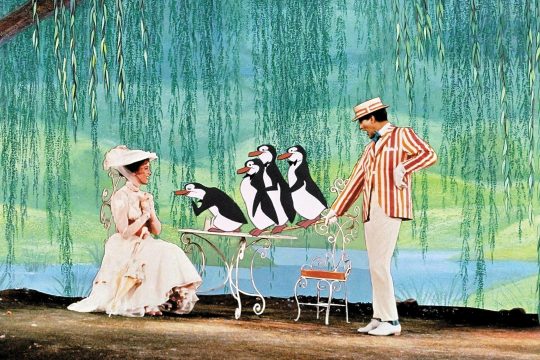
Julie Andrews, Dick Van Dyke and penguins, in ‘Mary Poppins’ (1964).
Generally speaking, and the Mary Poppins sequel aside, more contemporary efforts seek to subvert this feeling of harmony and control, instead embracing the chaos of two worlds colliding, the cartoons there to shock rather than sing. Henry Selick’s frequently nightmarish James and the Giant Peach (1996) leans into this crossover as something uncanny and macabre by combining live action with stop motion, as its young protagonist eats his way into another world, meeting mechanical sharks and man-eating rhinos. Sally Jane Black describes it as “riding the Burton-esque wave of mid-’90s mall goth trends and blending with the differently demonic Dahl story”.
Science-classroom staple Osmosis Jones (2001) finds that within the human body, the internal organs serve as cities full of drawn white-blood-cell cops. The late Stephen Hillenburg’s The Spongebob Squarepants Movie (2004) turns its real-life humans into living cartoons themselves, particularly in a bonkers sequence featuring David Hasselhoff basically turning into a speedboat.

David Hasselhoff picks up speed in ‘The Spongebob Squarepants Movie’ (2004).
The absurdity behind the collision of the drawn and the real is never better embodied than in another of our highest-rated live/animated hybrids. Released in 1988, Robert Zemeckis’ Who Framed Roger Rabbit shows off a deep understanding—narratively and aesthetically—of the material that it’s parodying, seeking out the impeccable craftsmanship of legends such as director of animation Richard Williams (1993’s The Thief and the Cobbler), and his close collaborator Roy Naisbitt. The forced perspectives of Naisbitt’s mind-bending layouts provide much of the rocket fuel driving the film’s madcap cartoon opening.
Distributed by Walt Disney Pictures, Roger Rabbit utilizes the Disney stable of characters as well as the Looney Tunes cast to harken back to America’s golden age of animation. It continues a familiar scenario where the ’toons themselves are autonomous actors (as also seen in Friz Freleng’s 1940 short You Ought to Be in Pictures, in which Daffy Duck convinces Porky Pig to try his acting luck in the big studios).

Daffy Duck plots his rise up the acting ranks in ‘You Ought to Be in Pictures’ (1940).
Through this conceit, Zemeckis is able to celebrate the craft of animation, while pastiching both Chinatown, the noir genre, and the mercenary nature of the film industry (“the best part is… they work for peanuts!” a studio exec says of the cast of Fantasia). As Eddie Valiant, Bob Hoskins’ skepticism and disdain towards “toons” is a giant parody of Disney’s more traditional approach to matching humans and drawings.
Adult audiences are catered for with plenty of euphemistic humor and in-jokes about the history of the medium. It’s both hilarious (“they… dropped a piano on him,” one character solemnly notes of his son) and just the beginning of Hollywood toying with feature-length stories in which people co-exist with cartoons, rather than dipping in and out of fantasy sequences. It’s not just about how the cartoons appear on the screen, but how the human world reacts to them, and Zemeckis gets a lot of mileage out of applying ’toon lunacy to our world.
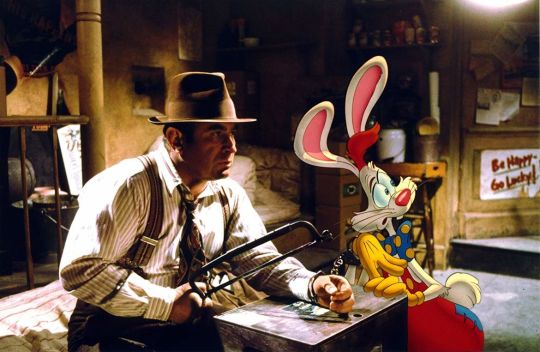
Bob Hoskins in ‘Who Framed Roger Rabbit?’ (1988).
The groundbreaking optical effects and compositing are excellent (and Hoskins’ amazing performance should also be credited for holding all of it together), but what makes Roger Rabbit such a hit is that sense of controlled chaos and a clever tonal weaving of violence and noirish seediness (“I’m not bad… I’m just drawn that way”) through the cartoony feel. And it is simply very, very funny.
It could be said that, with Roger Rabbit, Zemeckis unlocked the formula for how to modernize the live-action and animation hybrid, by leaning into a winking parody of what came before. It worked so perfectly well that it helped kickstart the ‘Disney renaissance' era of animation. Roger Rabbit has influenced every well-known live-action/animation hybrid produced since, proving that there is success and fun to be had by completely upending Mary Poppins-esque quirks. Even Disney’s delightful 2007 rom-com Enchanted makes comedy out of the idea of cartoons crossing that boundary.
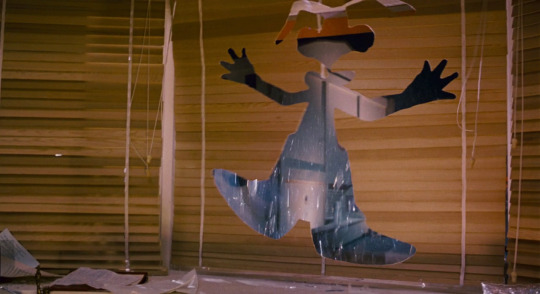
When a cartoon character meets real-world obstacles.
Even when done well, though, hybrids are not an automatic hit. Sitting at a 2.8-star average, Joe Dante’s stealthily great Looney Tunes: Back in Action (2003) is considered by the righteous to be the superior live-action/animated Looney Tunes hybrid, harkening back to the world of Chuck Jones and Frank Tashlin. SilentDawn states that the film deserves the nostalgic reverence reserved for Space Jam: “From gag to gag, set piece to set piece, Back in Action is utterly bonkers in its logic-free plotting and the constant manipulation of busy frames.”
With its Tinseltown parody, Back in Action pulls from the same bag of tricks as Roger Rabbit; here, the Looney Tunes characters are famous, self-entitled actors. Dante cranks the meta comedy up to eleven, opening the film with Matthew Lillard being accosted by Shaggy for his performance in the aforementioned Scooby Doo movie (and early on throwing in backhanded jokes about the practice of films like itself as one character yells, “I was brought in to leverage your synergy!”).
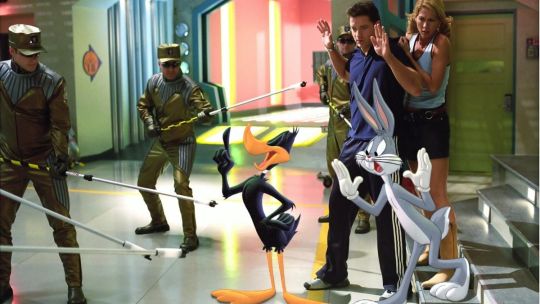
Daffy Duck with more non-stop banter in ‘Looney Tunes: Back in Action’ (2003).
Back in Action is even more technically complex than Roger Rabbit, seamlessly bringing Looney Tunes physics and visual language into the real world. Don’t forget that Dante had been here before, when he had Anthony banish Ethel into a cartoon-populated television show in his segment of Twilight Zone: The Movie. Another key to this seamlessness is star Brendan Fraser, at the height of his powers here as “Brendan Fraser’s stunt double”.
Like Hoskins before him, Fraser brings a wholehearted commitment to playing the fed-up straight man amidst cartoon zaniness. Fraser also brought that dedication to Henry Selick's Monkeybone (2001), a Roger Rabbit-inspired sex comedy that deploys a combo of stop-motion animation and live acting in a premise amusingly close to that of 1992’s Cool World (but more on that cult anomaly shortly). A commercial flop, Back in Action was the last cinematic outing for the Looney Tunes for some time.
Nowadays, when we think of live-action animation, it’s hard not to jump straight to an image of Michael Jordan’s arm stretching to do a half-court dunk to save the Looney Tunes from slavery. There’s not a lot that can be fully rationalized about the 1996 box-office smash, Space Jam. It is a bewildering cartoon advert for Michael Jordan’s baseball career, dreamed up off the back of his basketball retirement, while also mashing together different American icons. Never forget that the soundtrack—one that, according to Benjamin, “makes you have to throw ass”—includes a song with B-Real, Coolio, Method Man and LL Cool J.
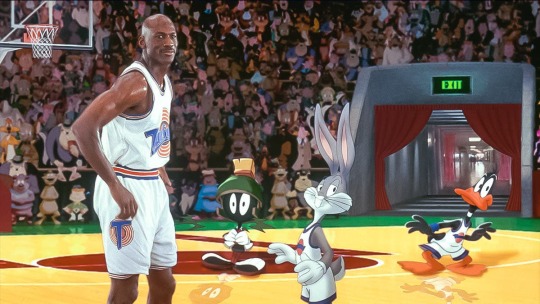
Michael Jordan and teammates in ‘Space Jam’ (1996).
Space Jam is a film inherently born to sell something, predicated on the existing success of a Nike commercial rather than any obvious passion for experimentation. But its pure strangeness, a growing nostalgia for the nineties, and meticulous compositing work from visual-effects supervisor Ed Jones and the film’s animation team (a number of whom also worked on both Roger Rabbit and Back in Action), have all kept it in the cultural memory.
The films is backwards, writes Jesse, in that it wants to distance itself from the very cartoons it leverages: “This really almost feels like a follow-up to Looney Tunes: Back in Action, rather than a predecessor, because it feels like someone watched the later movie, decided these Looney Tunes characters were a problem, and asked someone to make sure they were as secondary as possible.” That attempt to place all the agency in Jordan’s hands was a point of contention for Chuck Jones, the legendary Warner Bros cartoonist. He hated the film, stating that Bugs would never ask for help and would have dealt with the aliens in seven minutes.
Space Jam has its moments, however. Guy proclaims “there is nothing that Deadpool as a character will ever have to offer that isn’t done infinitely better by a good Bugs Bunny bit”. For some, its problems are a bit more straightforward, for others it’s a matter of safety in sport. But the overriding sentiments surrounding the film point to a sort of morbid fascination with the brazenness of its concept.

Holli Would (voiced by Kim Basinger) and Frank Harris (Brad Pitt) blur the lines in ‘Cool World’ (1992).
Existing in the same demented… space… as Space Jam, Paramount Pictures bought the idea for Cool World from Ralph Bakshi as it sought to have its own Roger Rabbit. While Brad Pitt described it as “Roger Rabbit on acid” ahead of release, Cool World itself looks like a nightmare version of Toontown. The film was universally panned at the time, caught awkwardly between being far too adult for children but too lacking in any real substance for adults (there’s something of a connective thread between Jessica Rabbit, Lola Bunny and Holli Would).
Ralph Bakshi’s risqué and calamitously horny formal experiment builds on the animator’s fascination with the relationship between the medium and the human body. Of course, he would go from the immensely detailed rotoscoping of Fire and Ice (1983) to clashing hand-drawn characters with real ones, something he had already touched upon in the seventies with Heavy Traffic and Coonskin, whose animated characters were drawn into real locations. But no one besides Bakshi quite knew what to do with the perverse concept of Brad Pitt as a noir detective trying to stop Gabriel Byrne’s cartoonist from having sex with a character that he drew—an animated Kim Basinger.
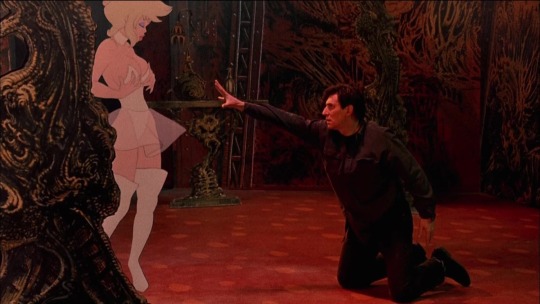
Jack Deebs (Gabriel Byrne) attempts to cross over to Hollie Would in ‘Cool World’ (1992).
Cool World’s awkwardness can be attributed to stilted interactions between Byrne, Pitt and the animated world, as well as studio meddling. Producer Frank Mancuso Jr (who was on the film due to his father running Paramount) demanded that the film be reworked into something PG-rated, against Bakshi’s wishes (he envisioned an R-rated horror), and the script was rewritten in secret. It went badly, so much so that Bakshi eventually punched Mancuso Jr in the face.
While Cool World averages two stars on Letterboxd, there are some enthusiastic holdouts. There are the people impressed by the insanity of it all, those who just love them a horny toon, and then there is Andrew, a five-star Cool World fan: “On the surface, it’s a Lovecraftian horror with Betty Boop as the villain, featuring a more impressive cityscape than Blade Runner and Dick Tracy combined, and multidimensional effects that make In the Mouth of Madness look like trash. The true star, however, proves to be the condensed surplus of unrelated gags clogging the arteries of the screen—in every corner is some of the silliest cel animation that will likely ever be created.”
There are even those who enjoy its “clear response to Who Framed Roger Rabbit”, with David writing that “the film presents a similar concept through the lens of the darkly comic, perverted world of the underground cartoonists”, though also noting that without Bakshi’s original script, the film is “a series of half steps and never really commits like it could”. Cool World feels both completely deranged and strangely low-energy, caught between different ideas as to how best to mix the two mediums. But it did give us a David Bowie jam.
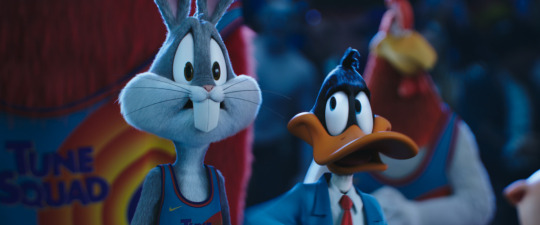
‘Space Jam: A New Legacy’ is in cinemas and on HBO Max now.
Craft is of course important, but generally speaking, maybe nowadays a commitment to silliness and a sincere love for the medium’s history is the thing that makes successful live-action/animation hybrids click. It’s an idea that doesn’t lend itself to being too cool, or even entirely palatable. The trick is to be as fully dotty as Mary Poppins, or steer into the gaucheness of the concept, à la Roger Rabbit and Looney Tunes: Back in Action.
It’s quite a tightrope to walk between good meta-comedy and a parade of references to intellectual property. The winningest strategy is to weave the characters into the tapestry of the plot and let the gags grow from there, rather than hoping their very inclusion is its own reward. Wait, you said what is coming out this week?
Related content
Rootfish Jones’s list of cartoons people are horny for
The 100 Sequences that Shaped Animation: the companion list to the Vulture story
Jose Moreno’s list of every animated film made from 1888 to the present
Follow Kambole on Letterboxd
#kambole campbell#mary poppins#ralph bakshi#hayao miyazaki#ghibli#disney#who framed roger rabbit#roger rabbit#spongebob squarepants#spongebob#animation#live action animation#live action animation hybrid#stop motion animation#stop motion#wes anderson#brad pitt#bob hoskins#genre#space jam#space jam a new legacy#michael jordan#lebron james#looney tunes#bugs bunny#daffy duck#warner bros#2d animation#letterboxd
25 notes
·
View notes
Text
well, you asked for it and here it is! a certified lesbiancolumbo #long post on noir recommendations!
i love film noir and noirvember is coming up real soon, so please enjoy this list of my favorites (if your favorite is not on here, i either haven’t seen it or hate it, sorry! or i just forgot about it or didn’t include it - this isn’t a list of EVERY noir!)
for me noir is all about the femme fatales and the poor bastards, and there’s plenty to talk about, so let’s dive in!
robert mitchum
when i think about who i want to watch in a film noir, it’s mitch. he’s just got a face i love and he just plays a sucker like no one else. but he’s also got such a range that he can be both the hardboiled street-smart hero while simultaneously being a poor bastard.
out of the past (1947, jacques tourneur) - honestly, this is one of my favorite films noir because it has ALL OF THE STAPLES. a man with a dangerous past working in a gas station (it is ALWAYS a gas station or a car repair shop), a beautiful and deadly woman, a plot that makes literally no sense. and you know what? i fucking love it. it’s got one of the sexiest kiss scenes in all of cinema. if you can only watch one, i would probably recommend this one. it’s everything that makes noir as a genre identifiable.
angel face (1953, otto preminger) - hahahahaha, this is one of the ULTIMATE poor bastard movies. i don’t want to say too much about it but holy shit, that ending had me screaming my ass off. jean simmons and mitch are fantastic.
the night of the hunter (1955, charles laughton) - i think this is my favorite mitchum noir, although i put it last on this portion because it’s a bit horror, a bit noir, and 100% worth your time. this is mitchum playing one of the most evil creatures in the history of cinema. charles laughton making this film and then never directing again was such a flex. he knew he had a masterpiece on the first fucking try.
humphrey bogart
you can’t really talk about noir without talking about humphrey bogart. this is another man who had The Range, but when i think of his best films, i keep coming back to the noir he made.
the maltese falcon (1941, john huston) - the stuff that dreams are made of! and by dreams i mean noir parodies for the rest of time. there’s a reason it’s parodied to death! it’s The film noir. a private eye, a femme fatale, peter lorre AND elisha cook jr. are there, another convoluted plot. it’s great. mary fucking astor.
dark passage (1947, delmer daves) - feels wrong to have bogie without betty, but also this one deserves its spot for its gimmick alone. it’s my favorite of the bogart and bacalls.
in a lonely place (1950, nicholas ray) - this film is to bogart what the night of the hunter was to mitchum. one of the bleakest and most depressing fucking films i have ever seen. i love it.
the harder they fall (1956, mark robson) - wanted to plug this because it’s bogie’s last film but it’s also a really interesting look at the sports world. but hey, maybe i’m just a sucker for movies about press agents who get way in over their heads...........................
burt lancaster
a man of average talent and attractiveness. i barely know anything about him. (for the people who will inevitable give me hate mail, i am being sarcastic)
criss cross (1949, robert siodmak) - this is MY list and i get to do literally WHATEVER I WANT and i am putting CRISS CROSS on this list. i think criss cross is the superior siodmak/lancaster noir. the beginning and ending are insane, and in the middle there’s a surreal heist sequence. rip to people who prefer the killers but i’m superior.
sorry, wrong number (1948, anatole litvak) - this is barbara stanwyck’s movie but burt is also very good as her stupid husband! if you, like me, lived and breathed high school forensics you are intimately familiar with this movie as kids all across the country have performed monologues from the play.
brute force (1947, jules dassin) - probably the most violent movie i’ve ever seen.
sweet smell of success (1957, alexander mackendrick) - i once watched this film every day for a week straight. if you’re following me and you haven’t watched this whaaaaat are you doing!
the femme fatales
i, personally, love when women are mean to men and kill them
detour (1945, edgar g. ullmer) - first off, this movie is only an hour long, and second of all, it contains one of the most insane performances i have ever seen in the form of ann savage. she contains so much hate and rage in her eyes, and turns it up to eleven almost the entire time she is on screen. i love that she is just so unabashedly angry! she has every right to be! dudes suck!
the letter (1940, william wyler) - this film’s noir-ness is... questionable, but i say it counts! it is one of the earliest of the genre, and it has an absolutely killer opening. i just love bette davis, and this film rips. i do wish they’d cast an asian woman to play the asian character, especially when they cast other asian actors for the other parts! but yknow. this is a film with influences you can trace in the more standard films noir that came later.
double indemnity (1944, billy wilder) - barbara. fucking. stanwyck.
gilda (1946, charles vidor) - i love this movie, even though i hate the way rita hayworth could never seem to escape it. it’s a classic for a reason, and there really never was another woman like gilda! this is one i look forward to revisiting.
halfway through making this post i realize it’s quite long and with no end in sight, so watch this space for a list of even deeper cuts
92 notes
·
View notes
Text
ALPHAVILLE
Alphaville is a film you must watch.
Not “watch” in the conventional sense, where you passively sit and let sound and image wash over you, the type of slickly made / often entertaining mainstream factory pap that explains the plot points every fifteen minutes for anybody who went to the bathroom / checked their phone / nodded off in the interim.
“Watch” in the sense you must follow it close, actively paying attention to what unspools before you.
It is not a difficult film to follow, but you’ll be lost if you blink.
Alphaville the motion picture can be described several different ways.
One way -- the most common way, the easiest to reduce down to a simple logline -- is the producers of the Lemmy Caution movies (a European version of the Sam Spade / Philip Marlowe type of private eye character) threw caution to the wind and asked then La Nouvelle Vague wunderkind Jean-Luc Goddard to direct the next installment of the character’s adventures, resulting in a weird / off beat combination of film noir and sci-fi.
This would be like the Shaft franchise asking David Lynch to direct an entry.
Another way -- and in my view, far more accurate yet more difficult to explain -- is that Alphaville is a series of discussions on philosophy / theology / poetry covered with a dream-like patina of surreal tough guy antics.
Goddard, a film and pop culture maven since childhood, wisely mixes science fiction with stereotypical private eye tropes to bring these discussions to life.
The science fiction aspect is the first and foremost element, but the world of the private eye is needed to make Alphaville complete.
Science fiction enables Goddard to bring deep philosophical questions up to the surface by couching them in sci-fi terms that let them be treated as concrete concepts instead of abstract ideals.
Alphaville isn’t the first film to do that, not by a long shot, but the challenge in using sci-fi to discuss big ideas is that the spectacle of the genre may overpower the theme, the form triumphing over the content.
Metropolis, as superlative as it is, is a prime example of that.
Goddard’s stroke of genius lay in double filtering his message through the stereotypes and cliches of private eye fiction. Eddie Constantine’s Lemmy Caution is brutish and confrontational but uses that as a physical shield to protect a very human soul. This enables Goddard, through the character, to anchor the flighty intellectual aspects of the story in a grim and gritty reality that filmgoers could readily identify with.
Even at its most grim and gritty points, Alphaville continues to play with pop culture, tongue firmly in cheek in the manner in which it examines its questions, but like a prophetic parable carrying a far deeper and more profound meaning than apparent on first blush.
The plot is very pulpish, suitable for either Planet Stories or Black Mask Detective.
Caution, posing as a journalist for Figaro-Pravada but actually secret agent 003, arrives at Alphaville, the capital of a far distant planet (or galaxy; Goddard either not knowing or not caring about the difference and using the terms interchangeably throughout the film).
Alphaville appears identical to Paris of 1965, and indeed references in the dialog suggest the story is taking place in the very near future.
Ostensibly there to do a story on Alphaville, in reality he’s tracking down two men: Professor Vonbraun (Howard Vernon), an American scientist formerly known as Nosferatu who has gone to Alphaville and established himself as the de facto human face and hands of Alpha 60, the computer that runs the society; or failing that, locating Henri Dickson (Akim Tamiroff), a previous Earth secret agent sent after Vonbraun who apparently vanished.
Caution’s mission is to return Vonbraun / Nosferatu or kill him; his superiors are aware Vonbraun is guiding Alpha 60 to launch a massive war against the rest of the galaxy. (Why Alpha 60 thinks this war is a good idea comprises the true heart of the picture.)
Caution is met soon after his arrival by Natacha Vonbraun (Anna Karina), a computer programmer for Alpha 60 and the (apparently adopted) daughter of Professor Vonbraun. She unintentionally manages to arrange an encounter between Caution and Vonbraun, resulting in Caution being targeted for first interrogation then recruitment by Vonbraun and Alpha 60.
If you’ve never heard of Alphaville before this, you may be imagining this in grandiose Blade Runner style, but Goddard wanted his film grounded in reality so he shot using real locations, no special effects (other than the screen images turning negative in a few instances), and no elaborate props or costumes.
Alphaville literally is Paris of 1965, and the soulless laboratories and indoctrination centers and police stations are what was then mid-century modern architecture.
What makes Alphaville the society so alien is that Vonbraun through Alpha 60 turned the world into a completely logical / unemotional civilization. Goddard combines nods to Russian Communism, Orwell’s 1984, and French existentialism to shape the society of Alphaville, at first glance seemingly so like our world, but soon revealed in word and gesture to be radically different.
Gene Roddenberry got logical civilizations all wrong with the planet Vulcan. A logical civilization would not become a world of high minded aesthetics but rather of haunted, empty human souls using sensuality in lieu of spiritual values.
Despite its supposedly logical / non-individualistic nature, Alpha 60 acts to preserve itself. It relentlessly controls the population through language and censorship, hammering down any outbursts of individuality or spiritual leanings (spiritual here expanded to more than conventional religion).
This desire for self-preservation, fueled and guided by Vonbraun, manifests itself in its plans for galactic war aimed at subjugating all other planets so that they may never threaten Alpha 60 (the film leaves as a far question which came first, the egg of Alpha 60’s antagonistic plans, or the hen of the other planets sending agents like Caution to thwart them).
Goddard was no computers expert and he made Alphaville long before artificial intelligence research moved from the theoretical to the practical, but he nonetheless raises an interesting issue: Alpha 60’s oppressive nature is clearly hardwired into its cybernetics by Vonbraun, yet Alpha 60 displays enormous curiosity in the very human traits it strives to eliminate while Vonbraun feels so sure of himself as Alpha 60’s chief architect that he fails to realize his creation is truly thinking for itself, not following the guidance he programmed in.
Much of the philosophical inquiry in Alphaville centers on religion, but here Goddard doesn’t use “religion” in the conventional term of a set of dogmas and creeds too often followed blindly and slavishly by the uninquisitive and the superstitious, but in the difference between philosophy and theology.
Theology is best described as a sub-set of philosophy dedicated to things of the spirit (i.e., abstract, not necessarily supernatural). It reflects how we think and feel about unknowable and unprovable concepts.
Philosophy and ethics can be tested; we can see if the golden rule is a viable philosophy to follow, we can judge if one view of how the world works is more accurate than another.
As stated, the key difference is that philosophy never presumes to postulate a final answer, and when it offers an insight it never claims that insight represents absolute reality.
Plato’s Allegory of the Cave is philosophy because it reflects a view of reality never meant to be taken literally; far too often religious devotees insist their parables be taken literally and at face value, not any deeper, more meaningful one.
Caution defeats Alpha 60 in the end by luring the computer into a trap of its own devising. Unable to grasp why humans value love and emotion and things of the spirit, it searches for meaning where it can find none because as advanced as it is, it cannot intuitively grasp their importance.
Alpha 60 realizes it is a little tin god, and in its futile attempt to elevate itself to the next level ends up destroying the very fabric of Alphaville’s social order.
Caution drives Natacha away from Alphaville to safety in the end, cautioning her like Lot’s wife not to look back. Natacha responds with a tentative expression of emotion: "Je vous aime" (and notice the use of the formal vous instead of the more intimate tu, she is starting to regain her humanity but a long road remains ahead of her).
In terms of execution, Alphaville is an extremely economical looking film (as well it should be since everything was shot on existing locations using the light weight cameras the French New Wave loved so dearly). The alienness comes across in the societal mannerisms, the elliptical dialog, and the odd juxtapositions found in the city.
Case in point: The phrase "I'm very well, thank you, you're welcome. Don’t mention it" is repeated frequently in the film.
At first it sounds like a typical social bromide, but as it is used again and again it takes on a more ominous, then sinister meaning.
It is not a polite thanks and dismissal but a warning, both to others and the speaker, not to entertain certain ideas.
Alpha 60 tries to control the citizens of Alphaville by controlling the language, banning certain words, changing the meanings of others. Characters refer to looking something up in the Bible more than once in the film, but only later is it revealed the Bible of Alphaville is a dictionary, and the salvation found within is the accepted language of the day.
The film maintains a dream-like quality throughout. Like most dreams, it certainly carries a strong, realistic feel yet at the same time is populated by surreal events and juxtapositions.
This dream-like quality plays well off the stereotypical private eye derring-do. Hard boiled shenanigans pop up almost randomly yet oddly not unexpectedly throughout the film viz Caution getting involved in a fist / gun fight with a hotel detective trying to spy on him as a “seductress third class” attempts to seduce him. It’s less than a minute of wild slam bang action and then it’s dismissed as if it never occurred, with Caution and the seductress continuing their cat and mouse game.
The film juxtaposes the opulent hotel lobby where Caution first checks in with the seedy rundown hotel lobby where he finds Dickson. The latter seems scarcely larger than Dickson’s seedy room, yet is crowded with its own staff (each engaged in some impossible to define task) and its own seductress third class waiting for clientele.
One of the most iconic scenes in Alphaville are the executions. Rebels against Alpha 60 (i.e., people who read =gasp!= poetry) walk out on a diving board over a swimming pool and are shot while making their last statement.
As they fall in the water a line of bathing beauties dive in, swim over, and drawing knives administer the coup de grace to the victim by repeatedly stabbing them underwater.
Which, incidentally, brings us to another point we need to acknowledge: How Goddard, Alphaville the film, and Alphaville the society treat women.
From our perspective almost 60 years later, we can look back at Alphaville and excuse its depiction of women by saying it was simply parodying the style of private eye movies of the era.
Which is true…but not enough.
Both French culture at that time and movies in general did not present what we’d consider an enlightened view of gender politics, and the females of Alphaville are all there for eye candy.
In some cases it works: The aforementioned synchronized bathing beauty executioners are so ludicrous as to be funny in a grim way, yet there are no other non-eye candy female characters to balance them out (there is a female cab driver, certainly unusual casting for a mid-1960s film, but she’s as gorgeous as all the other women).
And while one gets the idea behind each hotel employing professional seductresses (as an amenity in the world of Alphaville, as a commentary on the commodification of human relations in the film), today our reaction is more along the lines of “Is this really necessary?”
Far be it for me to tell Jean-Luc Goddard how to make movies, but it seems there could be half a dozen or more alternative ideas that would get the same point across without reducing women to this role.
Even Anna Karina’s Natacha gets subjugated to this mindset, serving mostly as a tour guide until the end of the film where she finally starts engaging more directly with the central conflict.
It’s not a comfortable look today, but we can live with it when viewed as a commentary on the style of the era. Compared with the Bond movies or almost any counter-culture film of the 1960s, it’s hardly the worst offender.
Here’s where I’m supposed to wrap things up and tell you to go watch the movie.
Okay, go watch the movie.
I’m not going to be hyperbolic and proclaim Alphaville a great movie because it’s a film set so far apart from the mainstream of cinema and the genres it mashed up that it’s not even an apples and oranges comparison but more like apples and the sound of autumn rain on the roof.
But seriously, you need to watch this movie.
© Buzz Dixon
#Alphaville#Jean-Luc Goddard#Lemmy Caution#science fiction#sci-fi#film noir#cinema#French New Wave#philosophy#theology#poetry#religion
5 notes
·
View notes
Text
The Apartment (1960)
"Some people take, some people get took. And they know they're getting took and there's nothing they can do about it."

Billy Wilder, the director who left Germany to build a career in Hollywood during the 1930s, had just scored a massive hit when he made The Apartment. Some Like It Hot, a transvestite comedy starring Tony Curtis and Jack Lemmon, had broken records and is still considered one of the greatest comedies of all time. A much sadder and perhaps more relevant project, The Apartment is sometimes claimed to be one of the greatest films of all time.
Lemmon once again worked with Wilder to play C.C. Baxter, a lonely office clerk who spends his days on a huge office floor full of identical desks, stretching as far as the eye of the camera can see. We meet Baxter for the first time on that floor, anonymously among all the others, a nobody.
Hoping for a promotion, however, he rents out his flat to his bosses so they can take their “sweethearts” there. Baxter waits outside in the cold, a cigarette in his hands, until he can go back inside to clean up the empty bottles and the rest of the debris from other people's entertainment. He's probably one of the loneliest men we've ever seen in a movie (not considering the average Scorsese / De Niro movie), and this unfortunate soul doesn't even have the luxury of entering his own apartment to be lonely.
Baxter has a soft spot for elevator attendant Fran Kubelick, played by a young Shirley MacLaine, but he doesn’t know that she has long had a forbidden romance with the big boss, Mr. Sheldrake (Fred MacMurray). That affair has now arrived at an end - just as Baxter's manipulative superiors keep him hanging on with eternal promises of promotion, Sheldrake does so with Kubelick by assuring her that he will divorce his wife. But not yet, now isn’t a good time.
It’s striking how Wilder's filmography begins with two clearly divergent tendencies: in the 1940s he made either full on comedies or full on dramatic films (the fantastic film noir Double Indemnity or the alcoholism drama The Lost Weekend).
However, as he progressed further in his career, those two tendencies became intertwined. His comedies grew increasingly bitter, his dramas more witty, in a cynical way, until the two were barely distinguishable. The Apartment is an important film in that regard - it’s the first time that these humorous and tragic elements have merged so clearly and so seamlessly. The film would set the standard for all attempts in the genre that followed.
This is primarily due to a truly brilliant scenario by Wilder and his permanent collaborator I.A.L. Diamond. We never get the feeling that The Apartment suffers from sudden tonal changes between humor and drama, as each scene is designed to have an indispensable place in the structure of the film. It's an immense achievement to incorporate themes like the pursuit of success at all costs, adultery and even suicide into one and the same story, and still earn the title of comedy.

Jack Lemmon portrays one of the best roles of his career as C.C. Baxter, a somewhat naive, well-meaning man who is only too eager to believe that the woman he loves is the only one who hasn’t yet succumbed to the corruption he sees around the office. When he discovers that this is the case, his mentality towards her changes to one of disapproval, if not aversion.
Notice the way Lemmon plays that: a man who put his dream woman on a pedestal and now finds out that she isn’t perfect after all. Baxter is disgusted by the sneaky adventures his superiors experience in his own bed, but he takes part in it, because promotion is the only way he sees to change his situation. In order to not be lonely anymore, to stop being a loser who spends his evenings - when he is at home - alone in front of the TV with a bite-sized meal.
The reason why this kind of film doesn't seem to age, at all, is because the screenplay deals with universal themes: we still have pathetic office men walking around who dream of becoming more than what they are, and in order to achieve that unwillingly play in other people’s games. And of course we still have despicable bosses who treat the women in their lives as objects they don't want to be bothered with once they’ve had their fun.
Wilder decided to shoot the film in black and white widescreen. Black and white, especially as the story takes place over the holiday season (nothing as depressing as being alone on New Year’s), and the film's grey tones effectively strip this time of year of all the true joy that would lie behind it. And widescreen, to emphasize how cold and emotionless the world of Baxter is. We see him roaming long corridors, huge offices and huge streets as a little man, anonymously. It’s only when the action moves to the titular apartment that some life comes into the sets, and even then a certain gloom lingers.

For example, pay attention to small observations throughout the film. Lemmon using a tennis racket to drain water from spaghetti - that's a funny scene, but it also serves a purpose. This is a man who uses a racket to prepare food; ladies and gentlemen, this isn’t a man that often receives guests. Also pay attention to the way Lemmon, MacLaine and MacMurray great each other with their last names throughout the film, and very often with “Mr.” or "Mrs.". Apparently the straitjacket of the office stays in place, under all circumstances. It's that kind of detail that says a lot about the care that was put into this film.
A description of the plot and themes might suggest a depressing drama, but The Apartment is a film with many faces, and of the many things it is, it’s also a very witty film, with fun running gags, puns and one-liners. My favourite: Baxter's neighbour who is convinced that Baxter is a sex machine going by the sounds coming through the wall and asks him to donate his body to science should he die.
The Apartment was seen as a satire on the American dream at its initial release, and to some extent it certainly is. Wilder was one of the greatest satirists the film world has ever seen, with a healthy suspicion of all forms of authority. The Apartment is one of his very best films.
@idasessions @missdubois @mad-prophet-of-the-airwaves @purecinema
#had always wanted to see this one#and was able to watch it by surprise a couple of days ago#didn’t dissapoint#also have some reviews of a couple more recently released films planned#the apartment#the apartment 1960#60’s cinema#classic cinema#billy wilder#i.a.l. diamond#shirley mcclaine#jack lemmon#fred macmurray#comedy#drama#romance#movies#films#movie reviews#movie review#film review#movie analysis#cinema#filmista
46 notes
·
View notes
Text
in the spirit of Sunday afternoons everywhere i have been dicking around thinking about Edward’s PI office because i am a horrible little goblin and i also want to try and have some consistency whenever i draw the office
you wanna see? no? understandable, have a good day- but if you do they’re under the cut (also incredibly rough, and constructed using Bastard;s Perspective)
the important thing to be rember is that this is meant to be roughly early 2000′s but a) Edward likes film noir and feels that there should be some maintenance of the key parts of the genre and b) you can’t tie me down to a solid time period because I’ll bite and scratch i swear i will
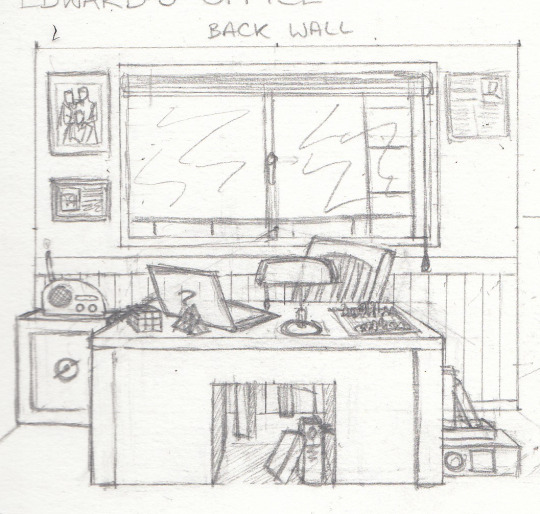
Edward’s desk with the requisite green shaded lamp, also a minor sample of his truly impressive Rubix cube collection, Also framed newspaper reports from his favourite crimes and that Query and Echo photo that I need to do a proper finished version of, because he’s just an old sentimentalist, really
The desk position allows him easy access to the window and thus the fire escape, in case he needs to make a speedy if irregular exit
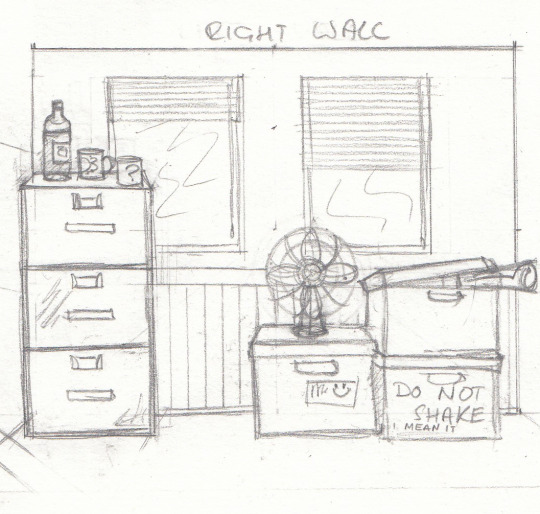
the sheer amount of nonsense you must accumulate over 25 years of themed crime, i mean; he needs to unpack some of these. what’s in the filing cabinet? secrets (and tax forms he should also get around to doing, possibly the worst part of going legal)

a bunch of this stuff (the hand with the bow, the metronome, the stereoscope) is taken from the background of the video for Nik Kershaw’s song The Riddle because I’m a bad person.
The beetles... well, it turns out there’s a genus of beetle called Aenigma, and I think I’m funny despite all evidence against this. Look, Edward appreciates a good reference too, I bet he would have something like this

you gotta have an wall with bits of string on it if you’re a PI, you just gotta, it’s the Law. Nothing says you have to have a gramophone, though, I think I was just getting carried away there. Still, Edward does have a lot of vinyl, because he thinks the sound quality is superior. Yep. Yep, I’m so sorry, he’s that sort of person.
so that’s Edward’s office, but there’s an outer bit as well, mainly the domain of Edward’s secretary, but also full of nonsense that I am going to have to draw consistently in the background every single time
... i may have made a horrible mistake.
well, personal crisis aside, here’s the door into Edward’s office, which slams in a very satisfying way, also some more filing cabinets, they always make a place look more professional! no one needs to know they’re full of Rubix cubes and old bits of wiring from the death traps...
the hat stand head is actually a phrenology head, I just think they look cool. Haven’t decided on a name for the head, but probably Elgar.

the other thing you gotta have as a PI is the frosted etched glass on your office door, so there you are. also, the various canes Edward has used across the years- i couldn’t tell you where I took them all from, but you’ve got the BTAS cane in there, and the Telltale one, and a few others. some of them are a bit dodgy to touch, actually- if they have some kind of weapon hidden in them, and the mechanisms gone a bit what with wear and tear, well- just don’t go waving them around, is all
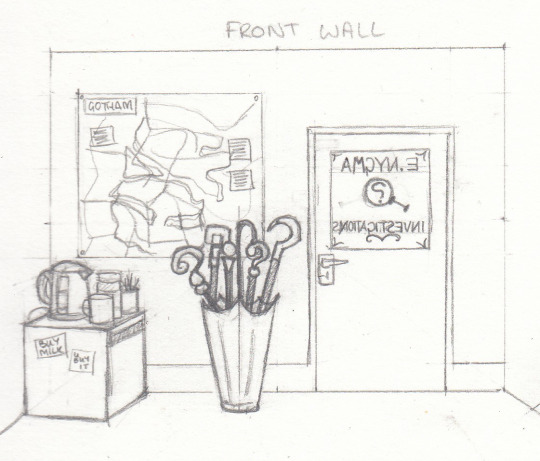
the secretary’s desk! nothing really to mention here.

and finally, a very dilapidated sofa- it’s not too bad to sit on, but if, hypothetically speaking, you had been spending the last 18 months sleeping on it because this agency is the last thing you have in all the world, well, it’s not quite so fun.
speaking hypothetically, of course. everything is fine. everything is completely fine

ok so, these are just rough indicators for myself but i quite like them. anyway. hope your Sunday is going ok. thanks for looking at this nonsense.
#riddler#edward nygma#riddler pi#comic planning#pi office#very rough sketches#but i wanna do good on the backgrounds for this comic#git gud at perspective bitch#or die trying
21 notes
·
View notes
Text
Blu-ray Review: The Fly Collection

David Cronenberg's The Fly is commonly cited as a remake that is superior to the original; an assertion that's difficult to argue, but both films are effective mashups of science fiction and horror for their time. In fact, the Fly franchise - the 1958 original, its two sequels, the remake, and its sequel - is quite good as a whole. Scream Factory has collected them all on Blu-ray in a box set dubbed The Fly Collection.
Each of the five films is housed in an individual Blu-ray case with original poster art, all of which are packaged inside a rigid slipcover case featuring new artwork. 20th Century Fox's existing high definition transfers have been utilized, and each presentation is crisp and clear. The movies are accompanied by a variety of newly-produced special features along with archival extras to make viewers buzz with excitement.
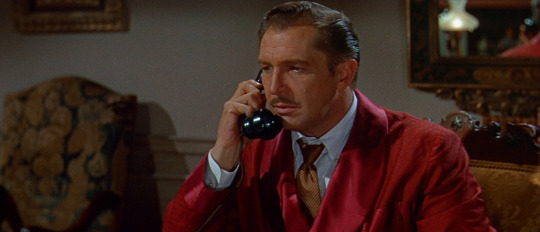
The Fly begins with an atypical murder-mystery, in which the mystery is not a whodunit but rather a whydunit. Helene Delambre (Patricia Owens, Sayonara) immediately confesses to killing her husband, scientist Andre Delambre (David Hedison, Live and Let Die), via hydraulic press - first to her husband's brother, Francois (Vincent Price, House on Haunted Hill), and then to the detective on the case, Inspector Charas (Herbert Marshall, Foreign Correspondent), - but she refuses to say why.
The slow build pays off with a dramatic reveal toward the end of an extended flashback sequence that makes up the film's second act. Andre invented a light-speed teleportation device, the disintegrator-integrator, that he eventually went through himself, only to have a pesky fly unknowingly join him. The result is a disquieting hybrid with a human body topped by a fly's head, revealed in an iconic shot that harkens back to the climax of The Phantom of the Opera.

The creature is ingrained in pop culture, but it's easy to imagine audiences in 1958 being shocked by the dramatic reveal. The theatrical trailer smartly features Vincent Price addressing the audience directly, teasing the "unearthly horror" without revealing anything. The special effects may be schlocky by modern standards, but the overall concept - based on the 1957 short story of the same name by George Langelaan - holds up quite well.
The Fly is directed by Kurt Neumann (Rocketship X-M) and written by James Clavell (The Great Escape), marking his only foray into genre pictures. Neumann died under mysterious circumstances shortly before the film's release, missing its commercial success as one of Fox's biggest hits of the year. Shot in CinemaScope with Color by Deluxe, the picture features cinematography by Karl Struss (The Great Dictator) that makes the laboratory's sleek production design pop.

The Fly's Blu-ray disc has two audio commentaries. The first is a new track featuring filmmakers/historians Steve Haberman (co-writer of Dracula: Dead and Loving It) and Constantine Nasr. It's educational but far more casual than the average historian commentary, and much better for it. The second is a light, cheery track with Hedison circa 2008. His memory is sharp, and he proudly discusses playing his character for the duration, including when his face is obscured by a cloth and, later, the fly mask.
Fly Trap: Catching a Classic is ported over from the 2007 DVD. The making-of featurette includes Hedison, Haberman, David Frankham, Tony Timpone, Donald F. Glut, and more, and even touches on the sequels, but at 11 minutes, it's only able to scratch the surface. A 1997 episode of Biography on Vincent Price features interviews with the likes of Roger Corman, Dennis Hopper, Roddy McDowall, Hazel Court, Norman Lloyd, and daughter Victoria Price. Extras are rounded out by a brief Fox Movietone News segment about movie monsters attending the film's premiere, along with the aforementioned trailer.

Fox was quick to capitalize on the success of The Fly with a sequel, Return of the Fly, released in 1959. This was a time when sequels were not the norm, mind you, so the budget is noticeably smaller. It was shot in a mere 10 days and recycles sets from the first film. CinemaScope was utlized agan but this time in black and white, which feels like a regression yet also lends itself to a film noir atmosphere. It greatly pales in comparison to its predecessor, naturally, but it fares rather well for a rushed, cheap followup.
Price is the only original cast member to reprise his role, although several other characters return to be played by different actors. Well on his way to genre stardom, thanks in no small part to The Fly, Price receives top billing this time around; although he's still not really the main character. That honor goes to Brett Halsey (The Devil's Honey) as Philippe Delambre, the now-adult son of Andre who wishes to continue his father's mysterious work, against Francois' wishes.
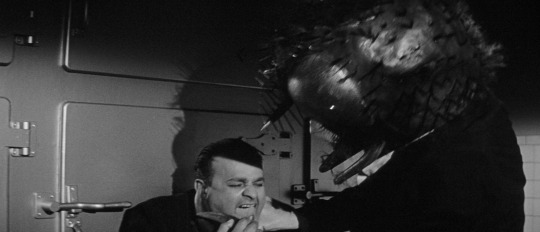
Despite Andre's attempts to destroy all traces of his research in the previous film, Philippe is able to successfully recreate the disintegrator-integrator with the assistance of his father's former associate, Alan Hinds (David Frankham, 101 Dalmatians). Hinds, however, is a dastardly double-crosser out to sabotage Philippe for his own gain. He ultimately causes Philippe to suffer the same fate as his father, turning him into a mutant fly creature.
Writer-director Edward Bernds (World Without End) rehashes a lot for the sequel, but there are some interesting twists. While the original story's creature largely garnered sympathy between shocks, the sequel's creature is a victim that's out for revenge. It's occasionally played for scares, although the mask - oversized and cheesy compared to the original - isn't nearly as effective this time around, but the viewer is rooting for, rather than sympathizing with, the monster as a hero.

Return of the Fly's Blu-ray disc boasts three audio commentaries, two of which are new. Frankham showcases a miraculously good memory for a 93-year-old, citing events from 50 years prior with ease. He's joined by friend/actor Jonathan David Dixon, who facilitates the conversation and fills in the blanks as needed. The actor's sweet demeanor and impressive recollection caused me to add his 2012 autobiography, Which One Was David?, to my to-read list.
Film historian/author Tom Weaver's new commentary is informative yet feels conversational; a welcome change of pace from the typically dry solo historian track. The third commentary is an archival session with Halsey and film historian/journalist David Del Valle. It may not be the most enlightening listen, as Halsey's memory isn't as strong as Frankham's, but it's enjoyable enough. Other special features include the theatrical trailer, a TV spot, and a still gallery.

The diminishing budget and resources between The Fly and Return of the Fly pales in comparison to the decline from Return to Curse of the Fly. Released in 1965, the third and final entry in the original series was produced in the United Kingdom. With Price unable to return, as he was under an iron-clad contract with American International Pictures, a new story was conceived. The go-for-broke sequel extends the mythology but distorts the familial lineage, and there's no fly this time around.
Taking another jump into the near future, the film opens with a woman, who we later come to know as Patricia Stanley (Carole Gray, Island of Terror), running away from a mental institution in her underwear. The slow motion sequence is more likely to be mistaken for a Roger Corman exploitation picture rather than identified as a studio sequel. Patricia runs into Andre Delambre's grandson, Martin (The Spy Who Loved Me), and the two quickly fall for one another despite their respective sordid pasts.

Beyond the opening attempt at titillation, this is a slow burner that's decidedly less familiar than its predecessor. Martin and his father, Henri (Brian Donlevy, The Quatermass Xperiment), have continued to make advancements using the technology developed by Andre. They have successfully teleported between Quebec and London with terrible consequences; deformed experiments gone wrong are kept locked away like prisoners. A grotesque effect in the last act is a fitting precursor to the remake.
Director Don Sharp (The Kiss of the Vampire) and writer Harry Spalding (The Watcher in the Woods) present an interesting moral quandary. Once again shot in CinemaScope black and white, the picture has a bit of a Gothic horror atmosphere. It's never fully harnessed, but the plot flirts with Patricia's descent into madness. An ill-advised Caucasian actress (Yvette Rees) playing an Asian role - with obvious fake eyelids to change the shape of her eyes - is a harsh reminder of racist practices in Hollywood.
Curse of the Fly's Blu-ray disc kicks off with an audio commentary with Haberman and Nasr, who once again provide a thorough, analytical look at the film, making a compelling argument for it being superior to Return. In new interviews, actress Mary Manson recalls going under complicated makeup to play the "very, very odd part" of the film's most integral creature, and continuity person Renee Glynne doesn't remember much about her work on the picture but offers a perspective from a rarely-heard crew position. The theatrical trailer, a TV spot, and a still gallery are also included.

When The Fly received the remake treatment in 1986, director David Cronenberg (Videodrome) put his patented body-horror spin on the concept. But beyond the Academy Award-winning makeup effects, which are aberrant and plentiful, lays a beautiful romance. The lean-paced film gets into it right away, opening with quirky scientist Seth Brundle (Jeff Goldblum, Jurassic Park) meeting journalist Veronica Quaife (Geena Davis, Beeteljuice).
Brundle courts Veronica by showing off his latest invention - teleportation devices known as telepods - and enlisting her to document his monumental findings. Brundle eventually goes through the telepod himself, unaware that a fly is in the device with him. While he's ostensibly unphased at first, he quickly discovers increased physical abilities. The benefits are short-lived, however, as he literally falls apart as the fly molecules overtake the human ones.

Unlike the original film, which hinged on a single, big reveal of a human-fly hybrid, Cronenberg and co-writer Charles Edward Pogue's (DragonHeart) script features a metamorphosis that slowly progresses - with gooey, practical effects by Chris Walas (Gremlins, Raiders of the Lost Ark) - throughout the film. Regular Cronenberg cinematographer Mark Irwin (Scream, There's Something About Mary) captures the atmosphere in an environment that begins cold and gets warmer as the film progresses.
Goldblum's awkward charms are at a peak. He and Davis were already a real-life couple, and their chemistry is palpable on screen. John Getz (Blood Simple) plays the third part of their love triangle as Stathis Borans, Veronica's boss and ex-boyfriend. But the intimacy extends beyond the relationships; the sparse film has but three essential roles, all of whom the viewer gets to know on a visceral level. The romance is supplemented by a heartstring-pulling score by Howard Shore (The Lord of the Rings, The Silence of the Lambs).
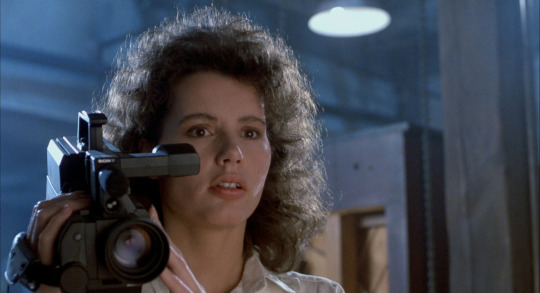
The Fly's Blu-ray disc offers two audio commentaries: an archival track with Cronenberg and a new one with The Artist as Monster: The Cinema of David Cronenberg author William Beard. Cronenberg's commentary is a fascinating mix of anecdotes and insight, such as the telepod design being based on a Ducati motorcycle cylinder and how he had to stop Davis from subconsciously mimicking Goldblum's distinct mannerisms. Beard's analytical track digs into the film's subtext and explores its themes, giving context to how it fits into Cronenberg's filmography. There's also a trivia track, in which bits of information pop up while the movie plays.
A new interview with comedy legend Mel Brooks (Blazing Saddles) - who produced The Fly under his Brooksfilms banner - is a highlight of the set. The 93-year-old Hollywood veteran chats about Cronenberg, Goldblum, David Lynch, and more. Other new interviews include producer Stuart Cornfeld, who reveals that Robert Bierman was going to direct until a family tragedy prevented it and that John Malkovich was originally sought for the lead role; Iriwn, who discusses the unique experience of working with Cronenberg, including their unfortunate falling out; and Shore, who explains how he implemented tragic themes for his first symphonic score of this size.

A plethora of existing special features are ported over. Fear of the Flesh: The Making of The Fly is a three-part documentary produced by Fox in 2005. The three stages of the film's production are covered by Goldblum, Davis, Getz, Walas, Pogue, Irwin, and more over the course of 135 minutes, not to mention extended/deleted interview segments. The Brundle Museum of Natural History features Walas sharing design concepts and effects materials alongside behind-the-scenes footage. Deleted and extended scenes, including the alternate ending, are also featured.
The disc contains a number of written works to peruse: Langelaan's original short story, Pogue's draft of the script, Cronenberg's rewrite of the script, and three 1986 articles about the film ("The Fly Papers" from Cinefex and "The Fly: New Buzz on an Old Theme" and "More About The Fly" from American Cinematographer). Other extras includes pre-production film tests, the original electronic press kit, a vintage profile on Cronenberg, various trailers, teasers, and TV spots, and still galleries (poster and lobby cards, publicity, behind the scenes, concept art, and four different effects galleries).

Much like the original The Fly, the remake's success led to a sequel. Released in 1989, The Fly II saw Walas assume the director's chair for the first time in his illustrious career. The script is written by Mick Garris (Hocus Pocus), Frank Darabont (The Shawshank Redemption), and Jim and Ken Wheat (Pitch Black). The pacing languishes in comparison to its predecessor, but it's not a bad followup overall. While Irwin and Shore's contributions are missed, the film reunites the talents of Hellraiser and Hellbound: Hellraiser II cinematographer Robin Vidgeon and composer Christopher Young.
The film opens with Veronica (recast with Saffron Henderson, Friday the 13th Part VIII: Jason Takes Manhattan) giving birth to Seth Brundle's baby - a squirming, amorphous creature - while Stathis (Getz, the only returning cast member, sporting a fake beard) looks on. The child, Martin Brundle (Eric Stoltz, Mask), suffers from a dramatically accelerated life cycle in terms of both physical growth and intelligence, so by his fifth birthday, he looks like he's in his 20s.

Martin is offered a job repairing his father's telepods in the laboratory in which he was raised. While working, he becomes romantically involved with a fellow employee, Beth Logan (Daphne Zuniga, Spaceballs). Their relationship is far less organic than the one depicted in the previous film, but it largely works. Martin eventually enters a cocoon-like state, only to emerge as a creature with virtually no humanity left for a final act that feels more like an Aliens knock-off than a Fly sequel.
Despite Walas helming several ambitious special effects - including a messy head crushing that initially earned the picture an X rating - he’s unable to outdo his landmark work on Cronenberg's film. The effects feel comparatively restrained with the exception of the the fly creature's final form, which looks a bit too cartoony. Yet, as beautifully tragic as Cronenberg's film is, The Fly II contains what is perhaps the franchise's most heart-wrenching scene: Martin watching his dog - his only friend - go through the telepod with disastrous results.
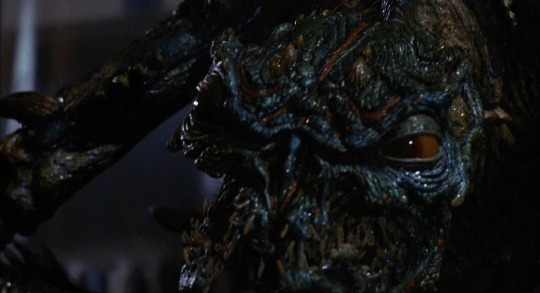
The Fly II's Blu-ray disc features new interviews with Cornfeld, who opens up about the difficulties of working with the studio on the sequel; Garris, who details his quite interesting original concept that greatly differs from the final product; Ken Wheat, who explains what he and his brother's draft introduced to the project before Darabont came on for the final rewrite; Vidgeon, who discusses working with Walas as a first-time director; Young, who talks about tapping into the emotional aspects and how his score differs from that of The Fly; and special effects artist Tom Sullivan (The Evil Dead), who talks collaborating on the creatures with other artists.
An audio commentary with Walas and film historian Bob Burns, whose extensive prop collection includes several pieces from The Fly II, is carried over. The old friends' camaraderie is apparent as Walas expounds upon the experience, including Davis' reasoning for not reprising her role. Transformations: Looking Back at The Fly II is a 48-minute retrospective from 2005 with Walas, Young, and producer Steven-Charles Jaffe (Ghost, Near Dark). Extended interviews with Walas (a sprawling 80 minutes) and Jaffe are also included.

The Fly Papers: The Buzz on Hollywood’s Scariest Insect is an hour-long TV documentary from 2000 about all five Fly films. Narrated by Star Trek's Lenoard Nimoy, it features Hugh Hefner, Ray Bradbury, Walas, Hedison, and more. Walas' crew's video production journal offers a behind-the-scenes look at the film's special effects. Young provides a master class in soundtrack composition in relation to his work in The Fly II. Other extras include storyboard-to-film comparisons with optional commentary by Walas; the original electronic press kit plus extended segments with Walas, Stoltz, and Zuniga; an alternate ending; a deleted scene; teaser and theatrical trailers; and still and storyboard galleries.
Genre fans should be afraid... be very afraid of not owning this set. Scream Factory has a reputation of going above and beyond for their collector's edition releases, but their box sets - like this and the recent The Omen Collection - are downright essential for horror completists. From presentation to special features, The Fly Collection does justice to each entry in the influential franchise.
The Fly Collection is available now on Blu-ray via Scream Factory.
#the fly#vincent price#jeff goldblum#geena davis#david cronenberg#scream factory#dvd#gift#review#article#the fly 2#return of the fly#curse of the fly#the fly ii#john getz#david hedison
29 notes
·
View notes
Text
https://www.popmatters.com/123302-second-sight-the-complete-collection-2496189035.html
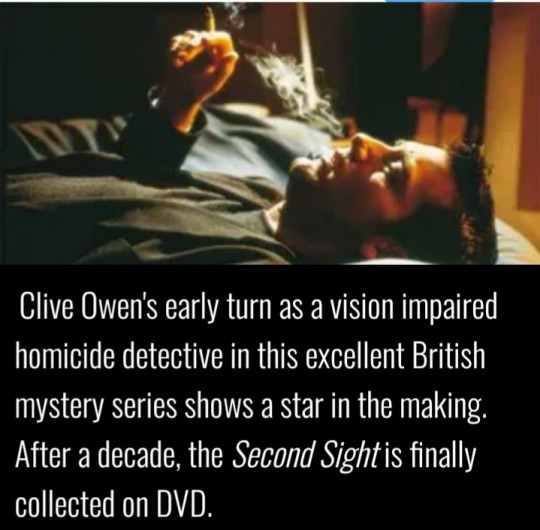
Clive Owen is, as they say, a tall glass of water. Ruggedly handsome, with sleepy, sad eyes, a deep rich voice, and cool and charisma to burn, he seems cut from a classic, if anachronistic, Hollywood mold. Combining a sort of arched-eyebrow knowingness with a heavy-browed brooding vulnerability, he is one part dashing leading man, two parts smoldering noir hunk.
I’m not sure the current film world quite knows what to do with him – though he is generally great in everything he’s been in, he always seems slightly out of place or time, like he just time warped from a late'40s noir that would star Robert Mitchum or William Holden. Perhaps the proper vehicles for Owen's talents and persona just don’t exist anymore, though some films have come close – Sin City and the vastly underrated Duplicity come to mind.
So it’s no surprise that his best work, and the role that catapulted him to fame in the UK, came in a millennial British mystery series, in which he plays a brilliant but brooding, sharp but tortured detective. Second Sight belongs to the same rich tradition of British mystery series as Prime Suspect, or Cracker, or any of the superior police procedurals that wash up on US shores on PBS. Conceived and written by veteran TV writer Paula Milne, Second Sight offers few actual genre surprises, but boasts a central character so richly developed (in such a short space) that he almost deserves equal footing with Helen Mirren’s iconic Jane Tennison.
Like Tennison, Ross Tanner is a brilliant DCI with London homicide. In the titular first “series” (oh the confusion trying to get around what to call each installment of these things, which are called series in the UK, but are more like TV movies by US sensibilities), Tanner is called in to investigate the mysterious death of a young college student visiting home for the weekend. He quickly begins to uncover a story more complex and sordid than it first appears (shocking, that!). Further difficulties arise as Tanner begins to experience various ocular disturbances – blurred vision, seeing things that aren’t there, a weird sort of starlight pixilation of the world around him.
A car crash lands him in front of an eye doctor, who diagnoses him with a rare, degenerative disease (AZOOR, an acronym for a lot of medical gobbledygook, but a real condition) of mysterious origins. Though not resulting in total blindness, the main characteristics, as portrayed from Tanner’s point of view with chintzy camera tricks here, are a certain fuzzed out quality to seeing the world, like it’s been made both super-bright and wrapped in gauze. Occasionally, certain things – faces, key objects – will come in to sharp focus. Or Tanner will see things that should be in a certain place but aren’t, his brain completing the image that is expected.
Tanner’s condition is the crux of the entire series, informing the show’s every aspect – and of course giving it its title. On a practical level, his waning eyesight is a seemingly insurmountable hindrance to his investigatory skills… or is it? There are hints, as the series progresses, especially in its later installments, of AZOOR granting Tanner some sort of mystical insight, allowing entry in to the minds of killers, or making connections in the chain of events that other detectives can’t see.
However, Second Sight never really commits to this angle, on how much importance to give to the quasi-supernatural aspects of his vision problem. It always just pulls back (rightly) from fully turning Tanner into some sort of mystic. It wants to have its cake and eat it too, presenting Tanner as both a dogged, rigorously intelligent investigator on the one hand, and as sort of a more dour, haunted Special Agent Cooper (minus the cherry pie and coffee obsession) on the other – solving cases more on luck, intuition and out and out hallucination, than because of any obvious sleuthing prowess. It’s an odd disconnect, the series at war with itself at what it wants its central character to be, and what do with its central gimmick.
The real surprise, though, is that this disconnect almost don’t matter. In fact, it dovetails nicely with what is really the key strength of Second Sight - the noirish mood of the series, and the richly realized psychological conflicts simmering within Tanner himself. Ultimately, the series is about a man at war with himself as the world he is accustomed to dealing with – a stark world of fact and certainty – crumbles away from his grasp.
His struggle to cope pulls him in every direction, and his pride and self-reliance take the biggest hit as he comes to have to depend on his comely new assistant, Catherine Tully (Claire Skinner), to literally be his eyes and support (and confidant, as she is the only one on the force in the know, at first). Throw on top of this custody squabbles with his ex-wife over his young son, and Tanner is slowly cooking to some sort of breakdown. Only focusing on the cases keeps him on track and from flying apart.
I wouldn’t go so far as to say that the mysteries themselves are incidental – there are four total, including the title series. They are more than mildly intriguing, if ultimately slight. They work best when they complement Tanner’s inner conflicts and personal problems. In this way, the later installments are actually better than the first one, which, though the longest and most complex of the lot, is the weakest.
“Second Sight” (the first, titular “episode”, as opposed to the series as a whole) suffers from too many red herrings, too much padding, and an overly chatty villain. The eventual solution is pretty well telescoped from early on, and only the constant degeneration of Tanner’s vision and his attempts to keep his condition secret keeps the ship afloat.
Much better is “Parasomnia”, the episode which best captures the noirish vibe the show is aiming for and highlights Tanner’s new unconventional investigatory skills. A gory murder, an amnesiac somnambulist femme fatale, and 90 minutes of Tanner slowly losing his mind to insomnia, paranoia and mounting frustration, this is the high point of the series, a riveting mini-film that would actually do well as a theatrical release.
The other two installments are engaging if not quite as enthralling. In “Hide and Seek”, Tanner is promoted to the head of a new crack unit of homicide, tackling stubborn and/or sensational cases. The first is a cold case of a murdered violinist, the unsolved status of which is a black eye on the face of the London PD. Meanwhile, Tanner and Tully’s relationship starts to buckle under the weight of his condition (how no one else notices on the staff that their chief is blind is beyond me – a great running gag if deliberate, a brutal oversight if not)
“Kingdom of the Blind” strains for political and personal poignancy with the case of a murdered black community leader, a decrepit old white supremacist, and Tanner’s finally coming to terms with his professional and personal life. The series ends here (for now), on an ambiguous note, Tanner striding forth into a blurry, hazy future (there are talks of reviving the show as a feature film, though details are… blurry for now).
Second Sight is finally collected in one DVD set a good decade after it went off the air. Previous releases of the individual installments had no special feature, and this has not been rectified with this collection, which is as bare bones as it gets. Spread out over five discs, the programs are slightly grainy, which actually enhances the look and feel of the show. I would have wanted something, anything, with Clive Owen talking about his first big starring role, before Hollywood came a calling.
2 notes
·
View notes
Link
Not many TV shows get a second act after cancellation. Even fewer get a third.
But not every TV show is "Veronica Mars," the neo-noir high school series that ran on UPN from 2004-2006, and then on CW for a third season, before its cancellation devastated its loyal fans. In 2014 the series was revived into a feature film funded by fans in a now infamous Kickstarter campaign. But Neptune, California, private investigator Veronica Mars (Kristen Bell) wasn't done yet.
"Veronica" is back, for an eight-episode revival on Hulu (streaming July 26, ★★★½ out of four), part of a trend of returning hit network sitcoms and cult dramas for belated sequel seasons, which has also resurfaced shows from "Roseanne" to "Gilmore Girls" with characters who are a decade (or two) older but perhaps no wiser.
Veronica isn't any wiser, either, but thankfully she doesn't feel like a high-school gumshoe in adult clothing. The fourth season is far superior to both the Kickstarter film (which was fun but slight) and the recent string of other revivals. With its themes of classism and systemic corruption, "Veronica" seamlessly translates into 2019. Unlike "Murphy Brown" or "Will & Grace," it isn't stuck in the past. Bell and series creator Rob Thomas also thankfully left the fan service behind and stuck to logical, smart storytelling.
One of the biggest strengths of the new season is its reckoning with the 2014 film, which leaned much further into nostalgia. In the movie, Veronica abandons her plans to seek employment at a high-profile New York City law firm – and her relationship with good-guy college sweetheart Piz (Chris Lowell) – and returns to Neptune to set up shop at her father Keith's (Enrico Colantoni) private-investigation agency. She also rekindles her relationship with sometime high-school boyfriend Logan Echolls (Jason Dohring).

As wonderful as it was to see Veronica return to Neptune and the beloved characters – including sometimes criminal Weevil (Francis Capra), Veronica's best friend Wallace (Percy Daggs III) and carefree party boy Dick Casablancas (Ryan Hansen) – the casual way she threw away her New York life was jarring. But the new season doesn't shy away from the enormity of Veronica's choice to abandon her legal career (just think of the student loans!) to establish her as the kind of down-and-out detective who populates pulpy dime-store novels that inspired the series.
The new mystery revolves around a series of bombings during Neptune's lucrative spring-break season, which may be part of a conspiracy to kill the tourist industry and free up high-priced real estate. Mars Investigations is hired by a wealthy congressman, whose brother's fiancé dies in the first explosion, to investigate what happened.
It takes a couple episodes for the bombing mystery to really take off. As in her high-school years, it's full of twists, weird evidence and red herrings, but those take a backseat to the relationships. Considering the Kickstarter film had a scant two hours to deal with a couple as complicated as Veronica and Logan – with their breakups and traumas – the new episodes take their sweet, necessary time painting both as adults.
Logan – once the perennial screw-up with a snarky retort for every conversation – is now far more emotionally evolved than Veronica, attending therapy and excelling in a military career. Veronica, who was so mature in high school that she showed up many of Neptune's adults, has regressed, shying from commitment and responsibility. But they're trying to make it work, in their very damaged way. It's a perfect example of how stories about committed couples can still be engaging, long after the will-they-won't-they drama has ended.
The season adds new faces, including J.K. Simmons as a gleeful ex-con working for Dick's father and real-estate mogul Big Dick Casablancas (David Starzyk) and a hilarious Patton Oswalt as a sad-sack pizza guy who's injured in a bombing and tries his hand at an amateur investigation. Veronica also gets a harsh look in the mirror from teen Matty (Izabela Vidovic), who loses her father to a bomb and has more than a little Veronica Mars in her.

Writers' willingness to add new characters and leave old ones who've outlived their usefulness behind (sorry, Wallace), is another strength of the new season. "Veronica" doesn't pretend it's still 2004. She's a thirty-something woman who still works her high-school job, and there's no pretending it's glamorous. And for this genre, and this character, the themes of wasted potential and existential angst fit perfectly. It's darker than the movie and even (sometimes) the original series, but Veronica was never going to sail off happily into the sunset, anyway.
Why not tell some good stories while she struggles?
28 notes
·
View notes
Text
My Baby Does Me: Chapter 26
POV: John Deacon x reader
Notes: masterlist, dudes
Warnings: goodness none; Deacy just isn’t that kind of guy.
Abstract: No more questions just you and I...
----------------------------
John Deacon walked through the garden path back to his green Mercedes-Benz. He gripped the handle, key in hand, lost in thought. It was always bittersweet, this car. It always made him think of her. Technically, her’s had been the blue one, though. Very much like her eyes, exactly like her eyes; they had joked, at the time, that their cars matched their eye colors, and perhaps they should switch models, so they could always see each other. It had been one of those romantic, foolish things people say when they’re in love and happy. Coming from anyone else, it would have made you cringe, but when it came from John and Veronica, well, people couldn’t help but see how sharply authentic their love was, and how unfairly happy they were.
God, they had been happy together. It was the kind of happiness that made other people unduly jealous and grossly resentful, and this only made them more devoted to each other. They fed off the attention from others and the passion from each other and used that to create the perfect marital balance. So much so that when John had suggested they switch cars, Veronica had loved the purity of the notion as much as she had the opportunity to make people sigh at their too real love. Freddie frequently said if he and Jim had tried half of the casually romantic things she and John had done, it would have come off as trying too hard or disingenuous; Jim had called them the real McCoy. Deacy knew better, though, and often reminded Freddie and Jim their own romance was a glorious sight to behold. Freddie called them a pair of old married couples, which Deacy had loved.
She had loved the idea. Simply loved it.
So, they had planned to switch cars, but Deacy had been held back during a recording session for Jazz, and had missed their scheduled rendezvous, so before they could switch cars, she had died.
Just like that. Happened everyday.
Is that what they call the ultimate sacrifice? Or a twist of fate?
If they had switched cars a handful of hours earlier, a measly three or four hours, Deacy could easily be the one who was dead now; the break-line had failed, and she couldn’t stop. In a weird way, he’d always blame himself for her death; he should have met her. He should have kept his promise. She should have been his priority. He’d have gladly died for her. If he could go back, he’d choose to switch cars in time instead of plucking his bass for some record he’d never be able to listen to again, let alone perform, without thinking of her. He’d choose her every damn time. Ultimate sacrifice is such a hollow way of putting it, he thought.
The fact was, Veronica was dead, and he was alive, and he could just as easily have died instead. This fact was the hardest one with which to live, even three years after the fact. It gnawed at him upon waking, and pulled his hair as he fell to sleep every night. It visited him on tour, and picked out his costume for each performance. It whispered to him from the audience, and played around his mind like a melody as catchy as anything Freddie had ever written.
She’s dead, she’s dead; and you’re alive, quite alive.
That is, until last night.
Last night, the immutable fact, which taunted Deacy relentlessly, softened. It hadn’t vanished, might never slip into a splendid quietude, but it had miraculously assuaged itself into a barely perceptible background noise. It had been unexpected, fantastic, and guilt-rendering. It wasn’t only having feelings for someone else that created this crippling guilt, but it was how good it felt to feel something other than a cleverly concealed nothingness. What caused him the most guilt wasn’t you; no, you were a gift. What caused him the most guilt was how good it felt to forget her.
How good it felt to forget her. What a terrible thing to think.
The guilt he could and would learn to deal with, to even escape, and to conquer. Forgetting her, though. He wasn’t so sure he could do that. He didn’t think he wanted to forget her. He wasn’t sure he had a choice; what if he didn’t have a choice? He hadn’t even considered the possibility that he’d just merely forget things about her given enough time. He had photographs, so he’d never forget what she looked like, or the color her eyes. What about things that couldn’t be captured? What about how she kissed? How it felt when she said his name? Or the way she put on her lipstick? The tunes she’d hum to herself--what if he forgot those? What if it just happened and he couldn’t stop it?
What if memories of you replaced his memories of her? This seemed like a preposterous notion. That wasn’t how memories worked. Veronica couldn’t be replaced like batteries in a remote. She couldn’t be thrown away. She would never be unnecessary or expendable. Though, neither were you. You had crashed into his line of sight, by chance, and had changed his entire life. With one glance, he felt it. Roots took hold of him, then, in that moment when he saw you, and they clawed, fighting for a foundation in the desert that his heart had become. You had whipped something up in him, as if suspired by divine breath, you had effortlessly coaxed something in him to awaken, something he thought had been long dead: Desire. Not even a desire for another person, though that had surely happened; rather, it had been a simpler desire altogether. A desire to live. And now that he was awake, he wasn’t sure he could go back to before.
But the guilt.
Well, he had put his heart away once. Leading up to the funeral, Deacy had stayed with Roger. Roger had catered to Deacy’s every demand--at least every demand he could realistically fulfill; his repeated request for him to bring Veronica back, to switch their cars, hadn’t been possible; though if anyone could have found a way, it would have been Roger. His realistic demands had been few, though. Deacy wanted to not move from a sofa, and watch films. Roger had gone to Deacy’s home and brought with him every VHS his friend had asked for with great speed and relief at being given a task to do. Deacy and Veronica had collected a vast film collection. They both loved everything about film. Would debate it for hours, would see everything in the theaters, even the bad ones, just for the sheer joy of experiencing it together. So, when Deacy’s one request had been to watch movies, well that had been easy to manage. Off to the Deacon residence Roger had gone to collect every film on Deacy’s list.
Though, what he had anticipated hadn’t been the bizarre film torture Deacy had insisted he put himself through. He had morbidly called it their “Greatest Hits.” It had started innocently enough with their top 10 favorite films, then gradually turned into their favorite twenty, thirty, fifty films. Deacy was determined to not move from Roger’s ultra modern lime green sofa and big screen TV until he had finished them all. He was dead-set on watching film after film with a rotating cast of his band mates and Jim, while crying silently, mouthing along with the lines in the films they had so cherished. This torture persisted for three days straight before Deacy succumbed to an uneasy sleep, his first sleep since her death, mostly due to pure exhaustion and outright fear.
They’d all take shifts sitting with him, watching films from every genre; it hadn’t mattered what was on, high period romance, crime noir, or precise comedy: he sobbed, more or less, inconsolably. He’d tell stories of her, of them, what they had liked about Taxi Driver; how overrated and inaccurate to real love that Love Story had been; how The Way We Were would always make them cry; how Katharine Hepburn could do no wrong, and how Humphrey Bogart and Lauren Bacall would always be the sexist husband and wife on screen--they’d debate if you could literally watch them falling in love on screen, and how romantic that was to have it captured on film forever; how The Godfather: Part II was superior to The Godfather; she had loved Robert De Niro, and he had loved Al Pacino; or how Sleuth was one of the funniest movies ever made that no one ever talked about.
And as each film had progressed, as each celluloid memory flickered in front of his eyes, he had packed away a portion of his heart. Sealing it away forever behind a wall of layered film strips and light projectors, behind a wall of celebrity and fame. Well, he had certainly successfully put his heart to the side for a hefty chunk of time, so why not also put aside the guilt? Why not the guilt, indeed? Why couldn’t he push aside the guilt for you? Like he had his heart for her? Maybe it could even be like a trade? He could take his heart back, embrace feeling once more, as he had embraced you, in exchange for the self-flagellating guilt. Trading guilt for a heart seemed like a much better deal, especially since it was a guilt so perverse Veronica would never have wanted him to feel it.
Well, the other fact of the matter was he knew you were worth it. You hadn’t known each other for a long time, but he had known love before; he knew what it felt like, sounded like, looked like; you could be that. Sure, it wouldn't be the same as with Veronica, but it shouldn’t be; you were both very different people; he was different now, too. He could never love like he had before, without fear and realism. Love for him now would be pragmatic; not to say it wouldn’t be romantic, because he was a ride or die romantic. However, he would never again believe that love was forever, undying, and could survive anything. Because, the fact of the matter was, it couldn’t.
Deacy pulled the handle, and entered his green Mercedes-Benz. His grey-green eyes flashed in the light before he hid them behind a pair of black aviators. He drove in the direction of his home, tapping out tunes only he could hear on his steering wheel. He had this series of notes stuck in his head; it was a little funky, a little spicy; it was going to be a hard sell. He had the distinct feeling the entire record was going to be a hard sell. Tonight would settle the path for the record once and for all. At least he’d have you there to strengthen his resolve. It helped Freddie was on his side, too.
Although, it wasn’t good there were sides at all. He hated Roger wasn’t on his side. Absolutely detested his hot hotheadedness and his viper sting when he thought you were wrong; it would be nothing short of a battle. He needed armor, then. He need to prepare his own stinger and cutting lines.
Shying away from an actual townhouse (pretentious) and an apartment (too many people and zero privacy) Deacy owned a detached Victorian house in St. John’s Wood. It had a fading yellow brick exterior Deacy greatly treasured; it was happily gated and had a large lawn obscured from view. Six bedrooms, as he and Veronica had wanted children, but hadn’t gotten around to it. He thought about selling the house, but as his grief abated, he knew he couldn’t just get rid of it. It would be like getting rid of his left arm; moving on didn’t need to be literal, usually it was a shifting state of mind more than anything else.
Besides, like the others, they had named their home. As he pulled up, the plaque reading Manderley greeted him. Manderley was the name of house in the film Rebecca, which they had loved. He parked his car, and made his way up the entrance and into his home. He sighed. Sometimes, he had to stop himself from calling her name when he returned home. Today wasn’t one of those days, however; it was a day where he remembered her fondly and without harm.
He started unbuttoning his shirt as he made his way past the first living room (completely shelved in with films) and kitchen (slender and accented in coppers and vibrant teals) and up to the third floor bedroom, his bedroom. He threw his clothes in the hamper, mostly undressed by the time he reached his room. The walls were the darkest blue, like the sky at night, and the ceiling glinted like the pacific ocean. He passed quickly into the master bathroom, bypassing the tub of honey-colored marble, and danced into the glass door shower. Upon finishing, he wrapped a couple large blood red towels around himself and proceed to the kitchen for his first meal of the day. He started some water boiling, threw in some salt.
He went into the first living room, picked out Saturday Night Fever and started that playing. He went back to the kitchen, threw some pasta into the boiling water, and chopped some carrots, sat some peas aside, and began to lightly sear some prosciutto. He sat that to the side, and added some butter to another pan and water and began to cook the vegetables. He readied some heavy whipping cream, garlic butter, and Parmesan. Eventually, given time and enough heat, all was ready; he tossed it together, and made his way to the first living room.
Sitting on the massively proportioned C-shaped sofa, Deacy sank into his meal and Saturday Night Fever. He’d have to pick you up eventually, and he’d have to tell you about Veronica eventually, too, but for now he enjoyed the dancing, the music, and the fever.
------------------
Tag List: @phantom-fangirl-stuff @triggeredpossum @obsessedwithrogertaylor @groupiie-love@partydulce@richiethotzierz@sophierobisonartfoundationblr@psychostarkid@teathymewithben@smittyjaws@just-ladyme@botinstqueen @mydogisthebest@little-welsh-wonder@maxjesty@deakysdiscos@yourealegendroger@marvellouspengwing@molethemollie@deakysgirl@arrowswithwifi@tardisgrump
31 notes
·
View notes
Text
The Greatest Rock/Metal Albums of the 21st Century.
21st century marks the most diverse decade for rock and metal continuation. Absorbing, if not radiated by the long progenitors from Led Zeppelin who cranked up their amps and Black Sabbath that turn it out murky and sinister grim, to the dazzling theatrical persona of KISS and Motley Crue, to the new level heavy metal confronter of Judas Priest and Iron Maiden, to the head crusher of Motorhead and Metallica, to the destructo maniac of Slayer and Kreator, to the prog menu offerer of King Crimson and Tool, and finally aligned to have some peculiar layers and brooding tendency of Korn. We have come a long way. Yet our engine keeps raging.
I have cumulated the finest, the most influential, and the most prominent albums released in the new millenium by the descendents that took their predecessors to a whole different level, sustain the genre, and move myriads of people to mosh.
In a particular order:
10. Avenged Sevenfold - City of Evil (Warner Bros, 2005).
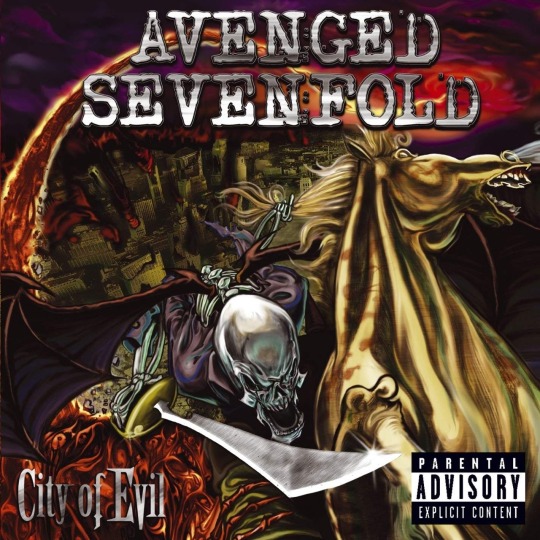
Rolling Stones magazine has named the sonically-punk with the flames of Iron Maiden, City of Evil on the last number of their 100 Greatest Album of All Time list. That should be a fair consideration since the extravagants like Beast and the Harlot, Bat Country, and Seize the Day altogether with the rest of the setlist ultimately transced the whole level and the destiny of the band as a leading force of eliticians in not so distant future. The 11 tracks have also successfully resurrected the triumph of classic guitar virtuosso portrait demonstrated on 80's as the talisman, Synyster Gates embarked over tons of appealing riffages and dueling solos which was buried after Nirvana and grunge breaktrough on the early 90's. Veteran and Ozzy Osbourne/Black Label Society guitarist, Zakk Wylde acknowledged him as a "Torchbearer" for arguably giving a birth and cultivating the guitar culture to the next generation.
9. Behemoth - The Satanist (Nuclear Blast, 2014).

The tenth album of Polish most profound extreme metal giant after Adam "Nergal"s battle with leukemia. Unlike the speed and precision exhibited over prior releases, the coagulated dense and horified cultish doom are found intensely throughout the setlist as to explicit the heretic messages. The result is astonishing and stronger than ever. More to add, The Satanist is pure, cathartic, flawlessly emotional, carefully-savage, and conquering by its complexity of repertoire within vivid and cinematical gradation as multi-dimensional tracks Messe Noire, In the Absence ov Light, Ora Pro Nobis Lucifer, and the leadoff Blow Your Trumpets Gabriel ravage in none but diabolical fervor. This album expansive flair has comprehensively unfolded the darkest caverns and creates the new standard of underground craftmanship.
8. Bring Me the Horizon - Sempiternal (RCA/Epitaph, 2013).

I wouldn't believe that i need to make Sempiternal in the cut. Who would have guessed? But i will beat every negation towards it. It is the album that eventually transforms Bring Me the Horizon from bunch of hipsters to one of the most important unit in the 21st century modern rock landscape. A year and a half after the release, Oliver Sykes and co. took over the world attention of rocking Wembley Arena, the same monumental venue where Queen — one of the biggest rock band in the history — was there doing the same story. It was approximately 12.000 attendees which made Sykes stated: "So this is our biggest show ever". The soaring Can You Feel My Heart, the furious The House of Wolves, the euphoric Shadow Moses, and the melodic of Sleepwalking are undeniably the new testament of rock music.
7. Lamb of God - Ashes of the Wake (Epic, 2004).

Count how many metal bands on the planet started after invented Laid to Rest or Now You've Got Something to Die For! It was countless. Lamb of God has became the crowned icon of "New Wave American Heavy Metal" and one of the most distinctive band in the scene. Their ferocious riffs, blistering drum works, lyrical contents, sound, even how to sing like Randy Blythe are largely imitated and seem to be the ideal menifesto of modern metal anatomy with obviously Ashes of the Wake as the highest pedestal. It contains tremendous chaos of 11 front-to-back blazing tracks immensely portrayed after Mark Morton - Willie Adler's virtuosity and of course, Chris Adler's voraciousity. Implying both abundance and how well they grasp the roots that will less likely be outnumbered.
6. Mastodon - Leviathan (Relapse, 2004).

We are now talking (and unravelling) the true genius minds of Atlanta-based extraordinary quartet. The newborn Metallica, Mastodon — the group that always exceed anyone's expectation — has seamlessly ranged their pinaccle from sludge to prog to avant-garde to even folk with staggering exponents of highly sophisticated masterpiece. With any fruition that comes in, the sheer Leviathan is believed as the opener tap. Written after Herman Merville's 1851 novel entitled "Moby Dick", the 46-minutes concept album is nothing but endless breathtaking experience of capturing bizarre Ode to the sea soundtrack. Blood and Thunder, I Am Ahab, and Aqua Dementia are torrent of forceful yet fascinating guttural power chords with Brann Dailor's tracherous drum tempo reflecting the theme while Iron Tusk sets sail upon muscular stoner riff and Naked Burn for menacing-tactical intro and flaunted visceral jarring chorus are hulking the imagery of the beast. Until the epic Hearts Alive with a glimpse of Metallica's The Call of Ktulu patiently reigns and all the greatness rendered.
5. Evanescence - Fallen (Wind-up, 2003).
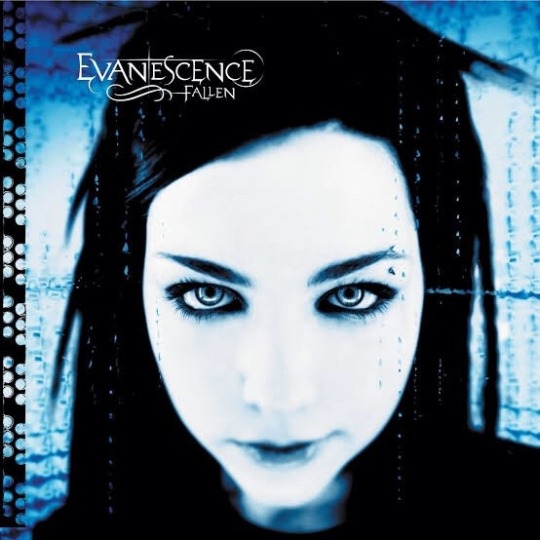
The album that made Evanescence — a small town band from Arkansas — a megastar in the blink of an eye. It was the second semester of 2003 where the breakthrough hit single, Bring Me to Life played million times on the radio around the globe (and MTV as well) picturing the female face lead singer and her gleaming voice, Amy Lee who started the band with the co-founder guitarist, Ben Moody (though the relationship didn't survive and separation happened in the midst of suporting Fallen tour). The fame that nowhere expected begun when the terrific duo met on a camp and cliche of having the same musical taste brought them to finally sign the major label Wind-up and dominated the world stages in a brief. Fallen with the added values of enchanting piano, symphonical strings livery, and haunting soundscape that most nu-metal groups didn't have at that time effortlessly stood-out and arised in comparison to even Linkin Park. Other songs served like the down-tuned goth Going Under and the everlasting ballad My Immortal are only legitimating their popularity.
4. Ghost - Prequelle (Loma Vista, 2018).

In our nearly five decades of heavy music, such names as Black Sabbath, Pink Floyd, Van Halen with their fantastic works and spirits have became a catalyst that will be remembered greatly in the faraway future for causing an enourmous impact to our community. Those that have bloomed and paved the way many artists to follow. And if there is a chance for this millenium bands to extend the list, Ghost will be the first to step up the grace.
This year, their most recent release Prequelle has been nominated for The Best Rock Album and its single Rats for Best Rock Song of 61st Grammy. An award that should be familiar since they have been winning it two times with Infestissumam (2013) — their second major label album — as The Best Hard Rock/Metal Album and Cirice — the single taken from previous album Meliora (2015) — as Best Metal Performance. A peak of a decade existence for one superior man behind the wheel, Tobias Forge. Appear himself as a satanic pope, Papa Emeritus I, II, III, Zero, and now with the newest fully renowned ascencion clergy Cardinal Copia has completely shaped the band's identity. But the latest Prequelle has more than to be attained to an award. Forge's admiration to film makes no surprise if any substance on the record is prone to get visualized and draw medieval realms so alive and real. He could blend joyous disco with scattered shock rock backbone for Dance Macabre, provide brilliant exotic pop-esque instrumental opus for Miasma, and close all the novelty and intellegiousness by a soothing grand finale of Life Eternal. That is the last strike.
3. Greenday - American Idiot (Reprise, 2004).

With the overwhelmed mainstream-breaking punk rock hit single American Idiot, it was an album (a concept album, for specific) everyone knew which handfully restored a big disappointment both sales and critical of their previous release. Taking the power back after four years gap with anti-Bush vitriol narration over long and merged tracks was everything we could expect from an ambition. Performing sarkastic American-post 9/11 political singable outcry and dragging down to emotionally-related suburban decline on Holiday/Boulevard of Broken Dreams, followed by californian sunset accoustic staccato and straighforward revv Give Me Novacaine/She's A Rebel, a love story of Whatsername where a street punk main actor St. Jimmy fell and how it all ended on Homecoming.
The grandiose worths 16 millions selling CD is the anthem of this generation where a generation ago pridefully have The Clash with the classic London Calling.
2. Slipknot - Iowa (Roadrunner, 2001).

The most brutal and confrontational album of 21st century nothing to this day can bear. That is the deal. A remorseless turmoil just from the first second of welcoming to the house of pain intro, (515) to the last 15 minutes epilogue of magnificent unrelenting drama title track, Iowa. Please recognize the insolent hate mantra "Here we go again motherfuckers" as Corey Taylor opens up and rips off anything with hammer to the face misanthropic followed track, People = Shit that seems a vulgar warning to extend the torture of their 1999 debut phenomenal self titled album. But things got tenfold. They were all damaged animals, making it excuriatingly worst instead, and wanted any living to hear them. That they fuck what trend you live up on bludgeoning bestial Heretic Anthem, that they are adamant bastards you can't bleach their darkness out on atmospherical assault New Abortion, that killing is their primal instinct on grinding jaw-breaker scorn Disasterpieces, that they are fucking obsolete machines on the scorching psychosis Everything Ends. There lies Neurosis-ian dressed Gently and never eschew Grammy nominated singles, Left Behind and My Plague.
All the violent rampage should be addressed to Ross Robinson (producer) for being able to wrap up the devastating times the band encountered in the studio and that was how its ruthless resonated the world where many people are pissed-off to everything. An absolute impossible album to be re-recorded due to its hell of organic material. Yet apart of any malevolence, Iowa is sadly, a gift to liberate your heart and soul.
Honourable mentions:
System of a Down - Toxicity (American/Columbia, 2001).
Converge - Jane Doe (Equal Vision, 2001).
My Chemical Romance - The Black Parade (Reprise, 2006).
1. Linkin Park - Hybrid Theory (Warner Bros, 2000).

The world seriously gives us no chance to break. After Lemmy, Bowie, now we have lost the most beautiful voice that represents our generation.
May rest in peace and honour, Chester Bennington.
We miss you everyday, and we do care if someone whose time runs out is you.
The album that took nu-metal to a whole different level forever and highly contributed to shape the sound that outbursted the 21st century. For two decades, Linkin Park has became the most iconic group on the planet. Breeding the bands like Bring Me the Horizon, Asking Alexandria, and Bullet For My Valentine (with their recent 2018 album, Gravity).
Hybrid Theory (which was the actual name of the band before settling to Linkin Park) is the sublime fusion of heavy metal, alternative rock, hip-hop, pop, and electronica desired only to make a lifetime change. It is truly no derivative. Yet recalling back, it was multiple rejections of label after label before it took off with Don Gillmore (previously worked with Eve 6, Lit, Pearl Jam) to produce the album and pushed the band excessively. It was the part that would not have regretted where all they saw afterwards and going on was all miracle. 28 millions copy sold should be a very serious sensastion everyone must have a seat to talk about. A rock n roll revival after Guns N' Roses's Appetite For Destruction (1987) so to speak. With angst to fuel, Hybrid Theory yielded the catchy single opener One Step Closer, the drug abuse easer Crawling, the unhinged paranoia Papercut, and the most well-known last single sung by anyone In the End. Not to mention its cohesive supplementaries A Place For My Head, Runaway, and My December that blur the foursome due to their equivalent prowess. Admit it, Linkin Park and Hybrid Theory are the gateway to rock and heavy metal empire.
#album#influential#21st century#top ten list#avenged sevenfold#behemoth#bring me the horizon#lamb of god#mastodon#evanescence#the band ghost#green day#slipknot#linkin park#black sabbath#led zeppelin#van halen#kiss#motley crue#judas priest#iron maiden#pink floyd#motorhead#metallica#slayernation#kreator#king crimson#tool#chester bennington#corey taylor
24 notes
·
View notes